#and i loved the parallels and between the retelling and the original myth
Note
Is there a real difference between something being a reimagining of Greek myths and something being inspired by it?
I mean, it's a difference that's kind of subjective IMO but the way I personally see it, it comes down to what the story itself is trying to be. Is it trying to be a retelling, or is it trying to be its own story that just happens to take elements from the myths for the fun of it?
A myth retelling will typically be doing just that, retelling a mythical story with its characters with maybe some aesthetic changes, artistic liberties, or tweaks to fit a new generation. Example: Stray Gods, Hades, Hadestown, Lore Olympus, etc. All these stories are retelling myths and tales while putting more modern or subversive twists on them. Hadestown may feature a version of the Underworld that's built on coal mines, but it's still the story of Orpheus and Eurydice. Hades may feature a version of Hades and Persephone who genuinely fell in love (Persephone was born to Demeter and a mortal man instead of Zeus which also removes the incest, and Persephone genuinely wanted to leave Olympus and saw marrying Hades as her way out), but they still gave Demeter her affiliations with winter and grieving the loss of her daughter.
Something that's simply myth inspired isn't necessarily trying to be accurate to the myths or retell them, they're just yoinking elements out of myths either directly or indirectly for the sake of fun and creativity. A recent example is Attack on Titan which is clearly referencing a lot of Norse mythology by the end with Ymir. Though an even bigger example of this is JRPG's, a lot of them tend to reference Greek and Norse myth in obvious or subtle ways, but aren't necessarily retelling those stories. Persona 3 uses a lot of Greek myth as the foundation for its story. The Ascians in Final Fantasy XIV go by Greek myth aliases such as Hermes and Hades, while there are raids in the game with Greek naming conventions (there's literally a raid boss in the newest set of Asphodelos raids named "Athena"). Tales of Symphonia is WWII meets Norse mythology, featuring subplots that tackle deep topics like discrimination, segregation and genocide (the "human ranches" are literally concentration camps) while also taking artistic inspiration from the Norse myths featuring the Great Kharlan Tree (the tree of life, Yggdrasil) and even the final boss' name is Yggdrasil, in the game's final cutscene Lloyd is given the opportunity to name the new reborn tree and while the audio fades out before you can hear what he names it, when you learn of Norse myth and how it inspired the game you just know he named it Yggdrasil (unfortunately they played it safer with the name "World Tree" in the game's sequel Dawn of the New World, but we don't talk about DotNW lmao). There are also a lot of religious allegories in JRPG's, particularly with Christianity, but that's another topic.
Point is, something that's simply taking inspiration from Greek myth or other mythologies isn't necessarily trying to retell those stories directly or even at all. Sometimes a piece of work is simply referencing them or enjoys the naming conventions or messaging of those original stories that it makes for a good parallel.
Not every story inspired by mythologies are attempting to retell them, but every retelling is inspired by the mythologies upon which they're based.
59 notes
·
View notes
Text
The Markiplier Connected Universe, and How To Understand The Characters Using Hadestown: An Analysis

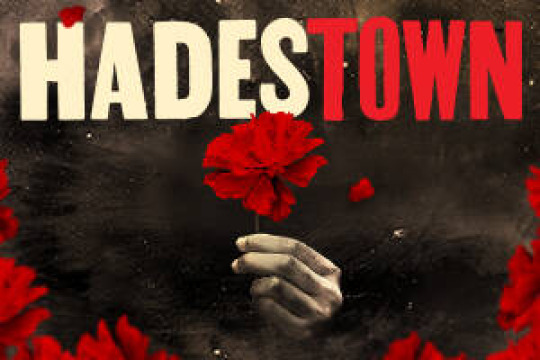
Ever since In Space: Part One aired, I’ve been hyperfixating on the story and characters of the Markiplier Connected Universe. Specifically, I’ve been thinking about The Actor, Celine, The DA, the Entity, and the theory of them all being trapped in stories that The Actor controls. Granted, the recent explanation livestream has for the most part discarded the idea that the With Markiplier series are all stories that The Actor is in control of, but given the content of DAMIEN, we can still run with the idea of them all being trapped in The Actor’s stories. My hyperfixation on the MCoU (Markiplier Connected Universe) ran along side what is a constant fixation in my mind: the music and themes of the Tony Award Winning show Hadestown. For those who don’t know, Hadestown is a retelling of the Greek myths Orpheus and Eurydice and Hades and Persephone; the show has the two relationships act as direct parallels to one another in a very powerful and moving way with their respective relationships impacting the lives of everyone involved. If you ever have the time, I highly recommend at least listening to the Original Broadway Cast recording on YouTube.
Disclaimer: the parallels I draw in this analysis are not meant to be seen as Mark's intention, nor inspiration. This is merely a way for me to share with you some cool similarities between two of my favorite bits of media at the moment, as well as help explain some of the character motivations we see (particularly when it comes to Actor). This analysis also operates under the theory of Actor being in control of the stories we see these characters in, be it true or not.
Now, you may be wondering how I could possibly draw parallels between a collection of YouTube Original series and characters from a Youtube channel and a Tony-Award-Winning musical. It’s quite simple: it all started- as many things often do- at the beginning. Or, in this case, the explanation livestream of Who Killed Markiplier. I was watching it in preparation for In Space when I came across the description that Mark used for how the Entity in the mansion works. He described as whispering in your ear, making you think that the ideas it’s giving you are actually your own ideas; how it preys on your worst qualities in order to get you to listen to it and do what it wants you to.
His description of the Entity then immediately reminded me of how The Fates are described in Hadestown: “always singing in the back of your mind”. It was at that moment that I was able to gain a better understanding of it. In Hadestown, the real antagonists are The Fates as they are oftentimes the ones that set things in motion: they torment Eurydice and convince her to accept Hades’ offer (despite her love for Orpheus) by preying on her hunger, they plant seeds of doubt in Orpheus that they later dredge up against him, they give Hades the idea to put the outcome of Orpheus’ journey to the underworld into his own hands (who then presents it like its his own to Hermes). It’s because of The Fates that Eurydice abandons Orpheus to go to Hadestown, and it’s because of The Fates that Orpheus is overcome by his doubt to the point where he ends up losing Eurydice forever. The Entity acts in the exact same way: it tells Mark to plot his revenge against William, tells him to steal his body, gets him to amend his plan when Celine comes in, etc. And it is from this connection that I was able to see the similarities between Hades and The Actor.


For those unfamiliar with Hadestown, one of the main conflicts in the show is the crumbling relationship between Hades and Persephone. They no longer remember what it was like to be young and in love, and this is shown by the songs Epic II and Chant where it depicts Hades as having been hardened by the time he spends alone in the underworld. He's described as being fueled by jealousy and doubt in his wife which then causes him to make changes to the underworld that try to compensate for what he believes Persephone loves about the world above: it's brighter and warmer there. So when Persephone confronts him on these changes (In the coldest time of year, why is it so hot down here?), he rationalizes at it being for her and that it was because he missed her so terribly rather than it being him trying to compensate for what he views as shortcomings of the underworld (Lover, you were gone so long; lover, I was lonesome...).
Now, there's not a lot that we know about the relationship between Actor and Celine before she ran off with William, but there's something that clearly changes between them during their time together. William alludes to this when he's giving his dramatic witness statement in WKM when he says, "My name is Markiplier now! Just look at all my money!", implying that the name change wasn't the only change that came along with Mark's profession as an actor. And while that might be just William's anger talking, there's more than likely a basis for his words. It's likely that Celine and Actor eventually got to a point in their relationship similar to Hades and Persephone where Actor started doing things that Celine didn't ask for/didn't approve of that Actor rationalized as being done for her. These two lines from Hadestown and DAMIEN solidify this similarity than these:
Hades: Lover, everything I do/I do it for the love of you
Actor: I GAVE UP EVERYTHING FOR HER!
In addition to these two lines, a variation of a lyric from Hades also draws a clear parallel between the two of them:

So, what does all this mean? Well, it means that if you want to understand The Actor's motivations more, then look to Hades. While they're not entire parallels, the two characters share the same pain of their wives leaving them to some capacity, as well as being manipulated by outside forces. In Act 2 of Hadestown, when Orpheus manages to remind the gods of their love and asks Hades if he and Eurydice can leave, The Fates step in and influence his thoughts to where his solution- to have there be a condition to their release that will most likely end up in Orpheus' failure- comes directly from The Fates themselves (Give 'em the rope, and they'll hang themselves!). Both men end up making decisions that result in tragedy from the direct influence of outside forces that work to manipulate and torment everyone involved.
Now that we have them sorted out, let's move on to their wives.
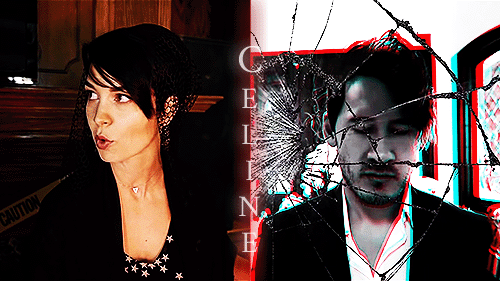

I will be honest and say that unlike Actor and Hades, there's not a lot that can be drawn between the characters of Celine and Persephone. The main reason is that by the end of their respective stories, the relationships with their husbands are the polar opposite of each other: where Persephone is reminded of the love she has for Hades, Celine wants to just body Actor and be done with it. However, there is a similarity between them in that they're known for leaving their husbands (although Persephone's leaving is more routine and necessary and Celine's is definitely more of a betrayal). There's also similarities between them in terms of the decent of their relationship in which Persephone frequently rejects the 'gilded cage' of Hadestown that her husband has made for her as she doesn't view that as what love really is. In the New York Workshop version of the show, Persephone gets this set of refrains in Chant II:
"Take it from a woman of my age/Love is not a gilded cage/All the wealth within these walls/Will never buy the thing called 'love'
Love was when he came to me/Begging on his bended knees/To please have pity on his heart/And let him lay me in the dirt
I felt his arms around me then/We didn't need a wedding bed/Dark seeds scattered on the ground/The wild birds were flying around
That's when I became his wife/But that was in another life/That was in another world/When I was a young girl"
I think that these refrains could possibly describe the time period early on in Celine and Actor's marriage when they were happily married, before Actor started to change. But outside of this, there can't be other parallels because quite simply, things have gotten too broken between Celine and Actor due to what the Actor did for Celine to be able to forgive him.
But now, let's move on to the character that I feel embodies my favorite Hadestown character: The DA and Eurydice.


Now, the DA holds parallels between Orpheus and Eurydice for quite a few reasons. At their story, they've been left behind in the mirror by the amalgamation we all know as Darkiplier. And while it's unclear as to whether or not they're taken to the void that they were in after William shot them, what is clear is that the DA is left in the manor. This heavily reminds me of how Eurydice gets sent back to Hadestown at the end of the show when Orpheus turns around to see if she's still there: both characters get turned on by people they deeply trusted (Eurydice by Orpheus, and the DA by Damien). But the parallels don't stop there.
If we assume that The Captain from In Space is indeed the DA from WKM, then the character progression of the DA is also similar to Eurydice. By the end of Hadestown, Eurydice goes from seeing the world as it is and finding little hope outside of what she needs to survive to completely seeing the world as it could be to where she would trust Orpheus to lead her back with absolute confidence in him. And we see something similar happen with the DA: they start out abandoned with little in the ways of hope and ends up making a deal that ensures their survival, just as Eurydice does, to not giving up on Engineer!Mark to the point where they’re willing to brave endless universes if it means finding him again and getting him to see what he’s done. As The Head Engineer says himself: “I guess I gave up hope. But you didn’t…you never did.”
And that concludes my analysis! Again, this is just my opinion and I in no way, shape, or form believe that Mark intended any of these similarities, much less knew about them. This is just something I’ve been thinking about for a while that’s allowed me to understand what Mark has said about the series as a whole, how there’s no intended villain and that these are all just stories about people making mistakes. Because that’s exactly what Hadestown is about: people making mistakes and hurting each other but they end up forgiving each other in the end. And in both stories, there’s a emphasis on hope and how the world could be much better if we allow ourselves to see how it could be despite the bad things.
As Orpheus says:
To the world we dream about…and, the world we live in now.
#markiplier#in space with markiplier#iswm spoilers#iswm#markiplier community#iswm part 1#mark fischbach#who killed markiplier#wkm the actor#wkm celine#wkm actor mark#wkm district attorney#wkm spoilers#hadestown#hadestown musical#hadestown hades#hades and persephone#persephone hadestown#orpheus and eurydice#hadestown orpheus#orpheus#eurydice#hades#persephone#the captain#engineer!mark#head engineer mark
71 notes
·
View notes
Text
Hadestown: Mythology Remixed
[The following essay contains MAJOR SPOILERS; YOU HAVE BEEN WARNED!]

Hadestown is a brilliant reinterpretation of the Greek myth of Orpheus and Eurydice. And not just because of the play’s updated setting; while transposing the plot to a Dust Bowl/Great Depression era company town—with the protagonist as the archetypal “starving artist,” Hades as a greedy industrialist, and Persephone as the proprietress of an underground speakeasy, delivering a bountiful “harvest” of wine and spirits to weary laborers—is certainly clever, cleverness alone does not necessarily a great adaptation make. Its true excellence lies in how it elaborates upon the ancient source material, adding complexity and nuance to the familiar tale.
One such embellishment is the fleshed-out relationship between Hades and Persephone; whereas the Lord of the Underworld and his abducted bride were happily wed in the original version, their marriage here is decidedly rockier. In keeping with the traditional canon, this iteration of Persephone is allowed to venture beyond her husband’s domain for six months of every year, thereby bringing spring to the lands outside of the kingdom’s walls (at this point, I should acknowledge that the narrative often vacillates between literalism and symbolism—which is absolutely fine by me, but could possibly alienate less adventurous audiences). And in her absence, insecurity—the nagging fear that she might abandon him for good—drives Hades to the brink of madness. Desperate to prove himself worthy of her love, he has performed a series of increasingly Herculean feats—his miners tunnel deep into the earth, extracting precious metals from mere stone; his furnaces burn red hot even in the dead of winter, smelting and reshaping raw ore; and his vast electrical grid ensures that his factories remain illuminated and operational twenty-four hours a day—in a misguided effort to impress her enough to expedite her return.
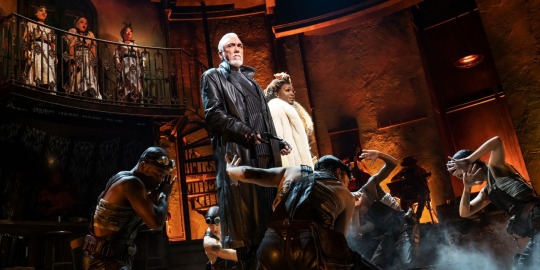
This is, of course, a futile endeavor: Persephone, being an avatar of nature, considers this desecration of the natural order to be utterly obscene—a betrayal of everything that she represents. Her resentment only serves to exacerbate Hades’ possessiveness; he permits her fewer opportunities to visit the surface and frequently cuts her excursions short, thus throwing the seasons into disarray.
In this context, the challenge that Hades issues to Orpheus during the show’s climax resonates with new significance. Navigating the perilous path back home in darkness and solitude, forbidden from glancing behind to confirm that Eurydice is indeed following him, our hero’s conflict perfectly mirrors the test of faith that his villainous counterpart must endure each time Persephone departs. Despite his sincerity and conviction, however, the singer’s experiences within the borders of Hadestown have irreparably tarnished his innocence; having witnessed oppression, exploitation, and dehumanization firsthand, his previously optimistic worldview is now thoroughly tainted by doubt. A notorious swindler like Hades wouldn’t hesitate to stack the odds in his own favor, after all; and Eurydice’s loyalty is hardly unwavering…
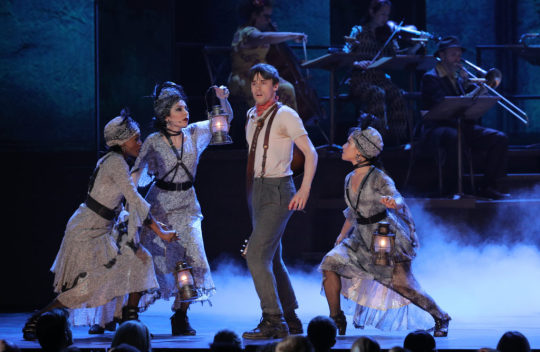
This narrative parallelism and thematic cohesion—juxtaposing the principal characters via mutual flaws, vulnerabilities, and moral failings—enriches Hadestown considerably, elevating it to the level of masterpiece. It may be an “old song,” but its imaginative innovations—a faster tempo, a few additional verses, some minor tweaks to the lyrics—radically transform its meaning and emotional impact. Which just goes to that a story never really goes stale, no matter how intimately you know it; a bit of extra spice can completely alter its flavor. And with each retelling, each reinvention, each variation on the well-worn formula, the author touches immortality.
Orpheus—folklore’s most iconic defier of death—would be pleased.
#Hadestown#Greek mythology#musical theater#Broadway#Orpheus and Eurydice#Orpheus#Eurydice#Hades#Persephone#writing#review
4 notes
·
View notes
Text
Avior and Starlight Hades AU
I can’t get it out of my head.
The myth of Hades and Persephone is one of my all time favs, and coincidentally there seems to be some similarities for me to play with in a Greek God AU. There are thousands of interpretations and retellings of this story, especially since the original text ‘Homeric Hymn to Demeter’ where the story is from, has pages missing.
~~
So Avior is obviously Hades in this scenario, and Starlight represents Persephone
I feel like there’s a good amount of parallels here
The most obvious of course being Hell/The Underworld
Depending on which myth you believe, there’s a couple of different versions, but the most popular seems to be where Hades kidnaps Persephone from her home on earth and takes her to the Underworld
Not completely unlike the situation between Avior and Starlight, especially the second time when Avior makes the choice to bring Starlight back to him
Now imagine instead of Persephone having to return everything six months because of the curse from eating the pomegranates, it’s Starlight. Able to break free only to be dragged back in every six months. Over and over
Or if we go by other myths then Persephone was in love with Hades, and wished to stay the whole year with her husband but was commanded by Zeus to go back to earth so the humans could have summer
In which case imagine Avior trying as hard as he can to get the person he loves out of the hell he’s trapped in, only for them to keep finding a way to get back to him, determined to stay
Can you tell I was a Percy Jackson Kid?
#I want to do one with Eros and Psyche too#redacted asmr#redacted Avior#redacted starlight#redacted meridian#dreamscape#hades#Persephone#hades and Persephone myth#Greek mythology#Greek god au#redacted asmr au#redacted headcanons#redacted asmr head canons#Redacted Audio
27 notes
·
View notes
Text
A thing I think about a lot, even not knowing much about LB6, is Oberon-Vortigern. I know his story more or less, and I've seen a lot of meta posts, and I know he's going to crush me into mushy feelings paste when I get to meet him. But like.
Listen. One of my first and most formative Arthuriana experiences was Jane Yolen's Merlin and the Dragons. If you don't know it, it's a retelling of the story of Merlin (well, Emrys) and Vortigern and the two dragons beneath the tower. Like that was the first real taste of Arthurian stories I had and it sticks to me hard. I've always been so excited whenever I see Vortigern in ANYTHING, like the Guy Ritchie Arthur movie more like one of my FAVORITES because LOOK ITS MY BOY. Vortigern and the dragons is literally my favorite Arthurian myth.
And so obviously, when I found out about Oberon-Vortigern, I absolutely lost my mind.
I know a lot of people love exploring the Oberon aspects, the Titania thing and all that, but for me I just want to sit here rolling around and thinking about PHH Vortigern, about what LB Vortigern could have been if he hadn't been affected, about, if you could fix his Spirit Origin — if PHH Vortigern had a similar problem; it says one thing in the Garden of Avalon novel and another in FGO according to the wiki but I can't help but think that a conceptual being so tied to the planet like Vortigern (aka a piece of Albion) would have suffered a lot being bound to a human shape and soul. Like it says how shitty Faerie Eyes can be for humans, if he had them, that would have been awful. It says it almost drove Castoria crazy, oof. There's got to be some parallels somewhere with Melusine, too.
IDK, I’m just...fascinated by his Vortigern aspect, I want to play with it so much, I’ve worked on a ton of PHH Vortigern headcanons -- did he meet little Artoria at all before she went to Ector? Did he meet Morgan as a child? How did he get on with Uther? Most importantly, Merlin. Merlin Merlin how did he meet him, what was their relationship, what happened between them, did PHH Vortigern impart any of his personality or quirks to Merlin, was he a brat too or was he more like Oberon-Vortigern once he drops the act, or was he somewhere in the middle? And what was his descent into madness and the black knight/dragon Artoria fought like, was it all at once, was it gradual, what was the point of no return?
And like I said, like, could PHH Vortigern ever be a Servant? Could there be a version of him ‘uncorrupted’ by either the Oberon Spirit Origin or whatever drove him mad in PHH? (I might have an idea for a Ruler class Vortigern (True) Servant oops) Just. Vortigern!!! So fascinating. I love him. I’m gonna love him more when I meet him.
#fateseriesblogging#chara: white dragon of the abyss#lb6 spoilers#not putting this in the tag mostly bc#i'm really not sure abt what fandoms like#i don't wanna accidentally piss anyone off w my thoughts lol
9 notes
·
View notes
Text
“What is this, the Dark Ages?”
Or, Arthurian themes and allusions in the Brotherhood of Steel mythos as seen in Fallout 4. (But that’s a lot of words.)

Yep. We're doing this.
First, some obligatory caveats: there is no single Arthurian canon, just 1500 years of assorted fanfic based on the whims of whoever was writing at the time. For this extremely highbrow Tumblr meta, I have ignored most of it and drawn on my favorites. Also Wikipedia.
Also, I am not an expert in Arthurian literature (or Fallout lore, come to that), and I preemptively beg the pardon of anyone who is.
Finally, in no way am I claiming that all these parallels and thematic echoes are deliberate or even significant. In fact, I'd break it down into:
Clearly deliberate allusions, whether in or out of universe;
Probably coincidence, but could be someone deliberately capitalizing on a coincidental similarity;
Almost certainly coincidence, but fun to speculate about; annnnd
Blatant Monty Python references. (Because of course there are.)
I'll start with the big one.
Arthur Maxson, boy king and unifier

(source)
So across all the retellings and variations of King Arthur’s life story, there are a few consistent elements, particularly in his early life and rise to power. Some of these threads are echoed in the Fallout universe, specifically (and unsurprisingly) in the person of Arthur Maxson.
Both the legendary King Arthur and Arthur Maxson were born with a claim to power lying in their ancestry, both were fostered away from their families, and both proved themselves in combat at a young age.
King Arthur united the warring kingdoms of Britain into a single entity, making them stronger against outsiders and receiving general admiration and acclaim. Arthur Maxson united the divided factions of the BoS after the events of Fallout 3 and is held in similarly high regard by his men.
The name Prydwen is a reference to the ship of the original King Arthur. Presumably, Arthur Maxson (or someone in the BoS who anticipated his promotion) christened the airship in a deliberate homage to the Arthurian myth.
King Arthur is associated with his legendary sword. I think it’s notable that Maxson’s legend is associated with a bladed weapon, too. ("He killed a DEATHCLAW with a COMBAT KNIFE!”)
Probably coincidence, but fun: the historical emperor Magnus Maximus, who pops up a lot in early Arthurian legend, was known in Welsh as... Macsen. (⌐■_■)
Round Table, but make it dieselpunk

(Continued under the cut.)
Moving away from obvious allusions and into some looser parallels:
Like the Round Table, the Brotherhood is an exclusive knightly order with its leader being the one able to open it up to his chosen few.
Like the Round Table, the BoS sees itself as defending human civilization against forces of chaos. (I’ll touch on their tech-hoarding tendencies when I get to the Grail stuff.) This idea of civilization in the face of chaos goes back to the BoS’s founding, even though the level of isolationism we see in most of the Fallout franchise is not exactly what founder Roger Maxson had in mind: “Notably, Maxson's ultimate intention was to establish the Brotherhood as an organization that works closely with people outside of the Brotherhood, as guardians of civilizations, not its gatekeepers.” (source) In a lot of ways, Arthur Maxson represents a return to his ancestor’s original ideals.
Renegade knights? Internal politics? Traitors within? We gotchu.
In both the medieval legends and in all chapters of the BoS we’ve seen, there’s a big focus on bloodlines (ew). Ironically, it’s probably Arthur Maxson’s unquestionable ancestry that allows him to be more progressive than either of his East Coast predecessors when it comes to boosting Brotherhood numbers by recruitment (even though you can still see a clear division between “born Brotherhood” and recruited soldiers, but that’s a topic for another day). Maxson sees himself as an Elder who "cares for the people"—however misguided and patronizing that attitude might be—and whatever else you might say about the guy, you can't say he doesn't believe he has a duty. Which brings us to…
Know Your Enemy: Danse as Gawain
Before I start this section, an acknowledgement of authorial bias:
Gawain, as portrayed in the Middle English poem Sir Gawain and the Green Knight, is my very favorite of King Arthur’s knights. (Other stories aren't always as flattering, but like I said at the outset: I'm sticking to the ones I like.)
That poem is my very favorite piece of medieval Arthurian literature. In this section, I'll refer to the modern English translation by Simon Armitage.
...that’s it, I have no other biases to disclose.
What? 👀

(Art: Clive Hicks-Jenkins)
All right. So in Sir Gawain and the Green Knight, you’ve got this himbo loyal knight of Arthur’s who finds himself caught up in... you know what, let me just paste in the Wikipedia summary. (The Toast, RIP, also did a pretty entertaining and more-or-less accurate recap.)
It describes how Sir Gawain, a knight of King Arthur's Round Table, accepts a challenge from a mysterious "Green Knight" who dares any knight to strike him with his axe if he will take a return blow in a year and a day. Gawain accepts and beheads him with his blow, at which the Green Knight stands up, picks up his head and reminds Gawain of the appointed time. In his struggles to keep his bargain, Gawain demonstrates chivalry and loyalty until his honour is called into question by a test involving the lord and the lady of the castle where he is a guest.
Don’t worry too much about the plot details, though; for this post, I’m more interested in the thematic parallels. The Green Knight story is full of contrasts: order vs. chaos, civilization vs. wilderness, mortal man vs. Other... but let’s start with Gawain himself.
Some stuff to know about Gawain:
He was "as good as the purest gold, devoid of vices but virtuous and loyal". Gawain took his principles more seriously even than the rest of Arthur’s knights, not out of pride but out of humility: "I would rather drop dead than default from duty," he says.
He’s faithful and honorable and never even tempted to betray an oath, even when offered every variety of seduction and riches, except for a single moment of weakness in a desperate desire not to be executed for random shit by powerful forces for reasons he doesn't understand.
Even though he doesn’t really understand why he needs to die, he sticks to his oath. Gawain's one weakness is a moment of desperate, private, human desire for survival. He'll submit to the headsman’s axe if he has to, but he'd still rather live.
Above all, Gawain is the ideal of a human man: he might be the bravest and loyal man there is, but he’s still fundamentally human.
You can probably see where I'm going with this.

A few more fun facts about Gawain that resonate with Paladin Danse’s story:
He’s got a bunch of really shitty brothers. (No comment.)
Gawain (SPOILERS!) doesn't actually end up beheaded, but he does willingly kneel for his execution and gets a cut on the throat as a reminder of his sin. And, uh, Danse can also get his throat cut! It doesn’t end as nicely but it’s, you know, a thing that can happen.
Gawain might be a really good guy, and he tries really hard to be one, but in the end he’s nothing more than that: there’s nothing supernatural about him, he has no special powers beyond his own principles and devotion. He’s just a dude doing his Best.
Wait, why not Danselot?
Oh, that guy? Here’s the thing.
Lancelot personifies the continental ideals of courtly love that became popular in the High Middle Ages. Central to his story is the prioritization of personal relationships and romantic feelings in a way that you don’t really see in Gawain's, at least in the Green Knight tale. (Later stories hook Gawain up with an extremely delightful lady, but even that is a different flavor of romance than Lancelot's and has more to do with Gawain honoring his word and his egalitarian treatment of women (hell yeah). In the poem, Gawain is impressed by Bertilak's wife but resists her temptation; in fact, the biggest risk is not that he'll yield to her advances but that he'll be discourteous to her, i.e., violate his principles and cause dishonor to his king and his host.)
Lancelot is driven by passions over principles in a way that Gawain never really is (at least in the stories I’m talking about; later writers have committed character assassination to various degrees). Yes, you could argue that both Gawain and Lancelot betray their oaths, but Lancelot’s betrayal is never, um, blind. He knows what he’s doing and makes a deliberate choice to prioritize his love for the queen over his love for the king. It doesn’t make him a bad guy—he too is an ideal knight with one fatal flaw—but his character isn’t as comparable to Paladin Danse.
Yeah, Gawain is (in most stories) a prince and a kinsman of Arthur’s, but he’s ultimately a native boy who doesn’t break the mold of a Knight of the Round Table. Likewise, Danse is portrayed as competent and valuable to the BoS, but not exceptional or breaking the mold of what a BoS soldier should be: he simply represents the ideal. Meanwhile, Lancelot is a foreign prince who was marked from childhood as special and fancy, and his storyline goes alllll over the place. (Much like this post.)
For example, Lancelot goes to absolutely absurd extremes to prove his devotion for no other reason than to prove it. (“I’ll do any useless humiliating thing you want. I’ll betray every oath except the one I made to you. That’s what love is!”) Gawain would never. Danse would never.
Ultimately, Gawain's tests are of his character and not of his love. And like Gawain, Danse’s devotion is to service and his principles, not to another person—even Arthur Maxson.
All that said, there are some similarities: both are beloved by Arthur, both are held up as the ideal of what a knight should be. And even if their fatal flaws are different, both make the point that no matter how good and brave and loyal they might be, no human being can be perfect.
(Except Galahad. Who is, as a result, very boring.)
I’ll conclude this section with a quote from someone else’s take on the Greek Knight poem:
I like Gawain. He’s not perfect, but he’s trying his best which is all any of us can do. He’s not like the other knights in the Arthurian legends who occasionally ‘accidentally’ kill women on their little adventures and then feel hard done by when they have to deal with the consequences of that. Gawain holds himself to a high standard – higher, it seems, than Arthur and his knights hold him to considering how hard they laugh when Gawain tells them how bad he feels about the whole thing.
I think Gawain is very relatable in this story. We all want to be better than we actually are.
And that, more than anything else, is Danse.
The Grail myth
What’s that? Lost relics of power? Better send some large armed men after ‘em!
The parallels to the BoS’s tech-hoarding ways are obvious enough that the games themselves lampshade them (albeit by way of Monty Python). But it also ties into the larger themes of “purity” versus “corruption” and the BoS’s self-image as a bastion between civilization and chaos. (See Maxson's line in response to the Sole Survivor’s quip about the Dark Ages: “Judging from the state of the world, it wouldn't be a stretch to say we're living in that era again.”)
But the ultimate futility of the Grail mission is also worthy of note. The BoS might want the power of prewar tech on their side, but they’re no more to be trusted with it than any other group of human beings. No matter how they try, the “corruption” of humanity can’t be overcome as long as they’re striving to harness power for their own ends. You can only achieve power by surrendering control of it.
The death of Arthur
The nature of gameplay being what it is, it's not guaranteed that the Arthur figure will be fatally betrayed, bringing Camelot down with him—but it's not unlikely, either.

Awkward.
Some final spitballing:
Outside the Brotherhood, there are some fun parallels of the Arthur myth with the rest of Fallout 4. Betrayal by one’s own son, for example.
The key difference between the BoS and the legendary Round Table: King Arthur’s knights, for all their flaws and human weaknesses, are usually presented as unambiguous Good Guys. The BoS is... a little more ambiguous...
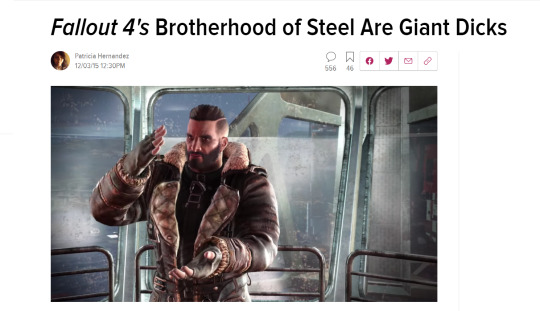
...but damn if they don’t think they're the good guys.
A-ad victoriam, fellas!
#fallout#fallout 4#brotherhood of steel#arthur maxson#paladin danse#sir gawain and the green knight#sir gawain#gawain#knights of the round table#king arthur#elder maxson#fallout 3#fallout lore#maxson#roger maxson#look mom I did a meta
306 notes
·
View notes
Photo

last year i posted a list of some of my favorite queer lit recommendations in honor of pride (which i still stand by, just ftr) and i thought it might be fun to try to make this into a bit of an annual tradition and keep the list more or less updated as time goes on and i (hopefully) read more queer books. who knows if i’ll be able to keep it up lol but we won’t know unless i try so here we go!
As per last year, recs will include links to the goodreads page (if applicable), any thoughts i have on the books, and any trigger warnings i can remember (please be forewarned that I do not have the best memory so I can’t guarantee that I’ll be able to catch everything). Including a mix of YA and adult, and excluding books i consider to be staples of the queer lit community (like Aristotle and Dante by Benjamin Alire Saenz is one of my favorite books of all time but i’m sure it’s the favorite of many of the people who are reading this list lol). Organized roughly by genre, then by author.
Contemporary
Felix Ever After by Kacen Callender
I’d like to preface this recommendation by saying the premise of this book originally had me quite hesitant. Like full disclosure, I’m not a big fan of the catfishing trope unless it’s done very carefully. That said, without spoiling anything I think it’s actually really well-handled in this story, and in a way I didn’t necessarily expect (in a good way). The main characters are very likeable and overall this is a book with a lot of heart. Highly recommend for those looking for a heartfelt story about a trans teen learning about love!
Features: gay trans protagonist and a variety of other queer characters in the supporting cast
Warnings: transphobia/misgendering as a significant side-plot, outing/deadnaming
Autobiography of Red by Anne Carson
First of all please mind the trigger warnings on this book (of which I’ve probably missed some rip it’s inevitable). I wouldn’t consider this an easy read by any means. That said it is also probably one of my favorite things I’ve read this year so far. It’s a modern retelling of a Greek myth (the tenth labor of Heracles if I’m not mistaken) melded with an original coming-of-age narrative, woven together seamlessly in poignant verse by the brilliant Anne Carson of the Sappho fragments translation fame (as well as infamous tumblr aesthetic quote “not to me, not if it’s you” etc. etc.). The interplay between ancient myth and modern themes/tropes is so fascinating, and the writing is just one punch in the gut after another (imo the verse makes it a bit easier to digest, your mileage may vary tho). i recommend this book for anyone who wants to be emotionally destroyed via quietly devastating poetry.
Features: mlm protagonist
Warnings: pedophilia/sexual assault of a child, incest
The Last True Poets of the Sea by Julia Drake
What is this?? Another modern retelling of a famous story??? I have a brand lol. Yes this is a (loose) retelling of Twelfth Night by William Shakespeare (AKA 17th century She’s the Man) but if you’re hesitant to give it a shot because of that let me tell you i did not even realize this was based on Twelfth Night until after I finished it and I don’t think that detracted from my enjoyment at all. The parallels are there for sure but this book is so much more than a retelling, it’s also a very compelling story about a complicated female protagonist who’s allowed to fuck up and have messy feelings while still being thoroughly sympathetic. i really love the relationship between Violet and her brother Sam, it’s so complex and heartwrenching, but of course the love story kicks ass too and also this book is just really well written!! the writer does a lot of cool things with narration and point of view and stylistic choices, definitely worth checking it out just for the writing imo! happens to be a nice bonus that i think everything else in this book is very good too.
Features: bisexual/pansexual (honestly I can’t remember exactly what label she uses sjknfskjnfs) wlw protagonist with male and female love interests
Warnings: themes of mental illness/depression, various portrayals of self-destructive behavior, hospitalization for suicide attempt as a significant sideplot
Fantasy/Sci-Fi
This Is How You Lose the Time War by Amal El-Mohtar and Max Gladstone
Let me preface this recommendation by saying I wouldn’t consider this the most accessible read. I suspect the prose style isn’t one that would work for everyone as it might feel overly wrought/purple to some which is completely understandable. That said, personally I devoured this book in one sitting so I had to give it a shout out. It’s basically this sprawlingly epic story about two mysteriously powerful agents fighting on opposite sides of a millennia-spanning war who eventually fall in love, and I just think the world building and concepts in this book are so enchanting. I’ll be the first to admit I’m not usually one to gravitate toward epistolary narratives but I’ll give anything a shot if it’s well done and I think the letter format of this story is exquisitely well done. like of course the content of the letters and how they develop these characters’ dynamics is very good, but i also really enjoyed reading about how they delivered the letters to each other and in what contexts they received the letters because I feel like those situations in themselves really helped flesh out the settings and characters. anyway i just think this is really beautifully written, would recommend if you’re in the mood for some truly wild storytelling!
Features: wlw protagonists
Warnings: violence/body horror and major character death
The Imperial Radch Trilogy (Ancillary Justice, Ancillary Sword, and Ancillary Mercy) and Provenance (standalone sequel) by Ann Leckie
With these lists I’ve more or less tried to limit myself to one book per writer so I’m definitely cheating with this one but I can’t not recommend this entire series in all its excellence. I truly feel that these books are now the benchmark of sci-fi for me, like never have i encountered an exploration of gender in a sci-fi context that was so richly drawn and satisfying to explore. The different conceptions of gender as explored in these stories are quite different from the typical western conception of the gender binary but Leckie does a really good job of fully immersing you into these new ways of thinking about gender, like it feels so seamless and organic. That aside the world-building in these books is very good - lots of complicated politics and such made more accessible through Leckie’s clear writing. And they’re all just thematically so complex in terms of questions of morality and justice and agency/autonomy/humanity, it’s been a long time since I had a reading experience that was as rewarding as tearing through this series.
Here’s how I would sum them up: if a sprawling series that thoroughly deconstructs questions of humanity/agency and justice from the perspective of a once-powerful military-grade AI intrigues you, I recommend starting with the trilogy! If a standalone story that more resembles heist shenanigans with a plucky heroine, complicated family dynamics, and unlikely friendships at its core is more your speed, I suggest giving Provenance a shot! If those both sound good why not read all of the above!
Features: Trilogy focuses on the Radch, a race of humans who do not have a conception of a gender binary (the author denotes this by referring to all Radchai characters with she/her pronouns); Provenance focuses on a different culture that recognizes a third gender (denoted with e/eir pronouns) with a tradition of not choosing one’s gender until adulthood; in general just some very interesting explorations of gender and sexuality in a sci-fi context
Warnings: genre-typical violence, prominent themes of imperialism/colonialism/genocide/war, consent/autonomy issues
Not Your Sidekick by C.B. Lee
I mostly recommend this one as a very sweet and feel-good queer story about superheroes in a vaguely futuristic society (as I know my taste in stories tend toward the tragically maudlin I’m trying to balance it out at least a little bit skjdnfskjnfs). The main character is very well-drawn and sympathetic, and her character arc in terms of coming to terms with her identity and agency is definitely one of my favorite parts of this book. my other favorite part of this book is the main romance which I think is just so, so sweet. Personally I found this read a bit predictable but that’s not necessarily a bad thing because it was also just an absurd amount of fun!
Features: bi wlw protagonist with a female love interest, trans character in the supporting cast
Warnings: genre-typical violence
One Last Stop by Casey McQuiston
Okay so I have absolutely no doubt this book will become a staple of the queer lit community (and if it doesn’t we will be having Words but seeing Red White and Royal Blue’s fanbase and the hype this book is already getting in the days after its release I would genuinely be surprised if it doesn’t) but I read it on the first day of this month and I haven’t been able to stop thinking about it since so I couldn’t not put this one on the list. i won’t say too much about it because if i let myself go i’ll probably never stop but i just. i’ve been waiting for a story like this. it feels so wonderfully self-indulgent in the best way, so warm and genuine and full of heart. it’s one of those books I feel like I read at the right time in my life - I also happen to be a 24 year old disaster queer with so much uncertainty about the future it hurts! - and it feels like the most sincere love letter to the queer community and reading this book felt like getting the best hug in the world by someone telling me I have a place in this world and I deserve it. It’s that kind of book and I have a feeling I’m going to be thinking about it for a really, really long time.
Features: bi wlw protagonist with a butch lesbian love interest and a supporting cast of trans/queer characters
Comics & Graphic Novels
Monstress by Marjorie M. Liu and Sana Takeda (note: this is an ongoing series; as of my writing this there are currently five volumes out but I believe individual issues/chapters are also available on a more regular basis)
Okay so this one is kind of an intense read and honestly I’m not sure that I would recommend it for everyone but I personally like it so much I wanted to give it a shout out. I really love the world-building in this series, it’s so intricate and well-thought out, and I love that the story is so female-centric. Like the society in this world is matriarchal with strong roots in asian culture and it shows, with such a rich and diverse cast of wonderfully complicated female characters and female relationships. Also the art in this series is just exquisite. i recommend this series for lovers of comics with rich steampunk-esque world-building and deeply flawed characters who also have a high tolerance for blood/gore.
Features: a wlw lead and other queer characters in the supporting/background cast (please note that sexuality/romance is generally not a major part of this story)
Warnings: body horror/gore (like… a lot of it), themes of imperialism/colonialism, cannibalism, child slavery/death
Laura Dean Keeps Breaking Up With Me by Mariko Tamaki and Rosemary Valero-O’Connell
Love the breathtakingly beautiful art in this, love the heartfelt coming of age storyline, love the focus on friendships and how to get out of a relationship that might not necessarily be the healthiest for you, love everything about this book. Absolute winner of a graphic novel.
Features: a wlw lead and other queer characters in the supporting cast
On A Sunbeam by Tillie Walden
I’m telling you this book has everything. Sweet pining across years in a boarding school setting? check. a vibrant supporting cast that basically hits the found family trope on the head? check. a captivating sci-fi setting with carefully detailed worldbuilding? check. themes of loneliness and connection across galaxies? check. Hauntingly gorgeous art that pulls everything together? check! Hands down one of the most beautiful graphic novels i’ve ever read.
Features: a wlw lead with a female love interest, a nonbinary supporting character and wlw in the supporting cast
Warnings: genre-typical violence, bullying, brief instance of misgendering
The Beechwood Helm by Letty Wilson (note: link goes to publisher’s website)
I am aware this is quite a niche pull, also the comic itself is very short (like under 50 pages) but I wanted to give Quindrie Press (a relatively new indie comics publisher) a shout-out because I recently backed a kickstarter they did to print some of their comics and I’m super impressed with their collection already, like i definitely think this is a publisher to keep your eye on. Personally I would recommend all the comics Quindrie Press currently offers (check out their site!) but I’m shouting out this one in particular because I think there’s just something so captivating and haunting about it. It’s an Arthurian-style story about a pair of knights who one day encounter a mysterious knight in a red helmet who challenges them to a duel to the death. I think this comic does an excellent job of quickly and effectively establishing its characters, relationships, and themes in such a small space, and I’m super into what this comic has to say about perpetuating the cycle of trauma/violence and how love/tenderness can help one break out of it. Doesn’t hurt that the art is gorgeous either! Please consider checking out and supporting indie creators/artists if you can!
Features: mlm protagonists
Warnings: violence/blood
Poetry & Non-Fiction
Drowned: A Mermaid’s Manifesto by Theresa Davis (note: link goes to publisher’s website)
Another very niche pull but I wanted to take this opportunity to shout out a poet/writer from my own local community. I found this collection in my favorite local bookstore and was immediately entranced by its simple yet evocative language. Please consider checking out and supporting indie creators/artists if you can!
Personal favorites: After This We Go Dark, Hypocrisy, Suite Movements
Devotions by Mary Oliver
This is basically a collection of Mary Oliver’s poems throughout her career so if you want a comprehensive primer of Mary Oliver’s poetry this is one I’d definitely recommend checking out! I mean what can I even say about Mary Oliver’s writing that hasn’t already been said. It truly is the epitome of tenderness and comfort; every time i read a poem by her I feel my heart grow a little lighter.
Personal favorites: I don’t want to be demure or respectable, Oxygen, You are standing at the edge of the woods, Singapore, One or Two Things, Wild Geese
Why Be Happy When You Could Be Normal? by Jeannette Winterson
I’ve always loved Jeannette Winterson’s writing - there’s just something about it that feels so punchy and poignant all at once - but I truly feel that this memoir is her writing at its very best. Heartwrenchingly honest writing, haunting ruminations on how complicated the concepts of family and love and grief can be, beautifully drawn atmosphere that seeps the whole narrative with a heaviness that aches but is also somehow breathtakingly accessible. This too ranks among some of my favorite reads this year.
#literature#book recs#pride month#lgbtqia#can you tell poetry is not my forte skjnfksjfns#i tried my best#sarah.txt#e: it seems posting this from mobile did something weird to the read more big rip#i hope this fixes it!...
41 notes
·
View notes
Note
You rebloged a Hades/Persephone pic a while ago, and when I came across it in my dash, my first thought was that it was Anakin/Padme. And now I'm musing on who'd play the parts of Hades, Persephone, Eurydice, and Orpheus if that play was Star Wars? Who would you fit into those roles, do you think?
I haven’t seen Hadestown (which I assume you’re referencing when you say play), so I can’t really answer on that basis, but I am a big mythology buff so I’ll talk about that.
Before I can get to the Star Wars, though, I gotta talk about the mythology.
So, I basically have two distinct versions of the Hades and Persephone story in my head. Mythology is fluid and alive so I’m not about saying that there’s an “original” version of any myth, but it is true that the ancient and the modern interpretations of the story are very different.
Most modern retellings of the Persephone myth are a love story. And I’m not at all knocking this. I ship Hades/Persephone just like everyone else on tumblr. (I am, however, uncomfortable with the fact that so many modern retellings make Demeter either the antagonist or the outright villain, when the ancient Greeks pretty clearly saw her as a victim, but one who ultimately won against the systems stacked against her. Her takedown of Zeus is pretty damn epic, okay.)
By contrast, although the myth has always had the trappings of marriage and fertility rites, the ancient story was not really a love story. It wasn’t really a rape story, either, although that is the metaphor used (and we tend to be very uncomfortable with that fact now). It really can’t even be called the story of Hades and Persephone, as Hades is less a character or even a person, and more a force of nature. Because in the classical context this is really a story about death.
The version of the myth connected with Eleusis, so far as we can tell, is indeed a fertility myth, but it’s not actually very concerned with human fertility. It’s instead concerned with the life, death, and resurrection of seeds, and its concern with humans lies in the way that they resemble seeds.
Persephone is the seed goddess. Like the grain, she falls into the earth and dies, and with the coming of the growing season she is resurrected. Hades, who was not merely the god of death but also an earth god, is the ground that the seed goddess falls into, the ground in which she is buried only to rise again. And humans, who also are buried in the earth at death, could expect to emulate the dying and rising goddess of Eleusis if they were initiated into her mysteries.
So there’s a number of different stories here. There’s the love story, which is often painted in modern retellings as between the god of the underworld and the goddess of spring (even though in the ancient world there is no evidence that Persephone was ever regarded as a spring goddess, and all of the stories about her feature her in her role as awesome and terrible ruler of the underworld, a role in which Hades himself actually appears very infrequently). And because it’s seen as a love story between a happy, flowery, bright woman and a dark and brooding man, it tends to get read onto…pretty much every female hero / male villain (or anti-hero) pairing that exists. That’s not a reading I’m particularly fond of, but it’s definitely out there, and that’s the reading I see behind most of the Hades/Persephone comparisons to Anakin/Padme.
There are several other stories present in the myth of Persephone, Hades, and Demeter, though. There’s the story of the mother whose child has been stolen away, either by kidnapping (if taken literally) or by death (metaphorically). There’s the story of a woman going up against the entire patriarchal structure of her society to get her daughter back - and winning, but not without permanent consequences. There’s the story of a dying and rising goddess who comes into her full and awesome power, and then returns to offer humans the gifts of the mysteries she has discovered, mysteries beyond even the comprehension of the immortal gods.
So…all of that to get back to Star Wars. As I said, I don’t actually see a very strong fit for this myth with canon (though the closest canon parallel with a Greek underworld myth, I think, is actually Luke in ROTJ, who is a pretty clear Orpheus figure, though he goes to retrieve his father not his lover, and unlike Orpheus he is successful).
However, my AU Anabasis is more or less a take on the Hades and Persephone myth, with a few twists. (Even the name of the story, Anabasis, is a Greek word and means “coming up (from the underworld).”) It fits pretty well into the modern version of the myth, with Anakin as Hades and Padme as Persephone, and even does the enemies to friends to lovers thing.
But it also plays around with a few of the ancient takes on the story, and mixes up a few of the associations. Anakin, not Padme, is the child stolen by a figure representing death (Palpatine). And, for the entirety of the backstory, Shmi, who is pretty clearly the Demeter figure here, believes that her child is dead. But Padme is also something of a Demeter figure in the way that she goes up against Palpatine and his entire Imperial system in order to reclaim both the democracy she loves and the child Palpatine stole. And it’s Anakin who ate the metaphorical pomegranate: he is a Sith trained in the Dark Side, and nothing can ever make that not true. He can, however, ultimately choose what to do with that and how to claim it for himself, and in that way he’s the Persephone figure, claiming her full and terrible power and entirely remaking the underworld and the meaning of death itself.
Both Anakin and Padme metaphorically “die” in their final confrontation with Palpatine (and Anakin was actually literally dead for a very brief period during surgery, before Barriss revived him). They don’t start a mystery religion in the aftermath of their resurrection, but they are both very closely associated with secrets, with hidden knowledge and the toppling of old systems. The Persephone of the Eleusinian mysteries was sometimes described as a liberator, which is a strong element in both Anakin and Padme’s stories.
As for other characters: Shmi is a close fit for Demeter, and Kitster, I think, would be the Hermes character (he’s both a trickster figure and plays the role of psychopomp). Sabe, who has a strong association with both Padme and Anakin, might fit as Hecate. Palpatine plays both the Zeus and the Hades role, depending on how you’re interpreting the myth. Most of the Jedi characters, though, don’t really have Greek analogues, and I’m not sure the other agents do either (though maybe an argument could be made for Dinsa as the Artemis to Anakin’s Persephone).
#replies#lionheadbookends#my meta#this is honestly more mythology meta than star wars#there is one other thing anabasis anakin has in common with my headcanons about hades#(tho those headcanons have no supporting textual evidence in mythology)#they are both gardeners#greek mythology#persephone#demeter#hades#star wars#anabasis#padme amidala#anakin skywalker#shmi skywalker#warning for mentions of#death#rape
256 notes
·
View notes
Text
HadesTown and POV
aka, Eurydice is actually the main character of HadesTown (or should be)
So I still have HadesTown meta very much on the brain right now, just tons of stuff about Hades vs. Orpheus and masculinity and all the visuals and tone of the story that comes from having the writer and director both be women, but there’s also one thing on my mind that’s a little more criticism. But first, a little context.
I went with my mother, and she struggled with the musical for a variety of reasons. Her criticism that stuck out to me was she called it, “all over the place” which I took to mean she had trouble following the story. Now, as a writer, I take that kind of criticism more seriously than I do content criticism ( “I don’t like the story because of xyz.” Well, maybe it’s just not for you.) So I’ve been thinking about it and I think I figured out the flaw in the structure she was referring to, and why it’s such a hard one for non-writers to articulate.
HadesTown, at least onstage, struggles somewhat with “point of view”. Who is telling the story? Who is the main character? Whose eyes are we seeing this story through?
Hermes is our narrator, but he tends to drop out on occasion to allow the drama to unfold without his filter.
Orpheus is technically our protagonist, as he is in the original myth. He is the one with a mission and a goal that he tries (and fails) to accomplish by the end. However, there are long stretches of the narrative, especially at the beginning when the audience is being introduced to the story, where he’s absent or off in his own little world. This makes for fascinating meta about masculinity in storytelling, but does create some internal confusion for an audience member trying to pick out who this story is about.
This problem is exacerbated by the atmospheric and gorgeous choice to have most of the cast on stage all the time. Hades and Persephone are there from the beginning, genteelly looking down from the balcony to the proceedings. Orpheus is often off to the side of the stage while he composes and it’s several songs into the narrative before he is front and center.
Then you have the fact that Orpheus/Eurydice and Hades/Persephone are being used as parallels for one another, and as a result they spread the story between them. The most confusing part of the setup of the story is when Orpheus plays his “unfinished” song to summon spring, and Persephone temporarily comes on stage. Now, this is quite a brilliant way to drag Hades and Persephone, as well as their story, into the narrative but I think if you’re not someone well versed in fantasy or myth, it may not be clear that Orpheus song is magical but because it was not yet finished, he couldn’t keep Persephone there for long.
The problem of portraying Orpheus as genuinely magical is compounded by the modern costume and set design. It’s gorgeous, but it doesn’t make it immediately clear that we’re in a fantasy setting where magic actually works, it takes a bit of mental gymnastics (especially difficult to pull off while trying to parse information from songs rather than spoken word) to realize this retelling’s use of Depression-era costume and set design is only meant to be evocative and creative, and does not signal that their story is being updated to a more “realistic” time without magic and therefore Orpheus’s musical magic is only metaphorical. His music’s power isn’t metaphorical, it’s real, but this clashes with his introduction as a poor boy working in some sort of shop or restaurant.
But to go back to point of view (POV), this is a problem one sees with a lot of early writers, especially those with a fanfic background, and HadesTown is fanfic in the sense that it is derivative and heavily relies on knowledge of a separate story, (the tales of Orpheus & Eurydice and of Hades & Persephone) for the audience to immediately follow along and be invested. This problem is that because the author assumes you know this tale as well as she does, it doesn’t really need to be introduced on its own. That’s fine, until you begin introducing new elements, like the idea of Hades being the Boss Man of a modern Depression-era town and Persephone is his depressed, drunken wife, or the idea of Orpheus as a poor boy (and not the son of a mythological king) and Eurydice as a scrappy runaway. Those are new elements that muddle the original narrative and require more setup as a result.
And then there’s Eurydice, who is much more fleshed out and brought center stage. I think it’s also clear that the female writer of the story had particular sympathy for her, but as with many writers, felt this character deserved more complicated motivationThe story has some amazing commentary on masculinity that I really want to get into in another essay, but it’s clear that it’s a female gaze story. Furthermore, Eurydice is transformed in HadesTown, at the very least to give her something to do and a reason for us to like her, because in the original she’s the quintessential damsel in distress and the fridged girlfriend all in one. She has no motivation besides, presumably, wanting to marry Orpheus and then wanting to be rescued by him when she’s killed on or just before her wedding day, but in HadesTown she becomes a heroine, if not the heroine of the story.
And here’s where I get to my one editorial tip for HadesTown, and why I think my mother wasn’t totally off base by saying it needed one more editing pass: Eurydice is the main character. The narrative voice clearly has sympathy for her, she goes on a journey to find food, she is the driving force behind much of the action, she is the one who brings change to Orpheus’s life and kicks off the narrative by asking him to sing his song. She is the one who acts, others react to her choices.
But since the original myth focuses on Orpheus, it feels a bit like the narrator or writer felt compelled to have him as “the protagonist” when really, he is the traditional love interest. He’s fairly passive, even in going to rescue Eurydice he has to be prompted by Hermes and it’s Eurydice going to look for food which stirs him from his musical trance. Furthermore, even in the visuals for HadesTown, Eurydice is the one driving Orpheus forward, even during her own rescue when they’re ascending from the Underworld.
However, we don’t really meet Eurydice until a few songs in and she is absent for long stretches on the stage. If the story had opened with her introduction superseding Orpheus, and made clearer that we’re seeing a reinvention of the story where Eurydice is the empowered one around whom events shift, I think we’d have a stronger, single narrative thread going through the story that through the haze of the music would be easier to follow. The building blocks are already there in the narrative, but the parallels with Hades/Persephone and the focus on Orpheus as a rescuer, albeit a fairly passive one, muddle the fact this is the story of Eurydice changing and influencing events and setting the action in motion.
We can criticize audience members for not “getting” the story or for not keeping up, but authors should be wary when doing so. Trouble following a story is sometimes a lack of attention or genre savvy by an audience member, but it can also be indicative of a muddled narrative.
Point of View, who is transmitting the action of the story to us, how and when are they relating the story to us, and how do they filter the world around them, is an incredible and incredibly advanced tool in the writer’s toolbox. It’s often invisible to the audience and to even advanced readers, however. It takes a lot of attention to notice and it can be hard to articulate why it’s confusing when a strong POV isn’t there.
Hamilton does not struggle with POV, we know when someone who isn’t Hamilton (usually Burr) is narrating because he takes center stage. Les Miserables has a huge ensemble cast, but we never question who the current song or scene is about, it’s usually Marius, Valjean, or Cosette and they take center stage when they give their view of the story. Phantom of the Opera has a somewhat more removed “once upon a time” ensemble POV because it takes place on a stage, but most of the time we’re seeing events from Christine or Raoul’s POV and they are center stage and loud as they observe events. The switch to the Phantom’s POV at the end of All I Ask Of You is jarring and shocking on purpose as a result, but again he takes center stage when he comments on the events he just witnessed.
By crowding the stage and having so many POV characters witnessing and commenting on events at once, from the Fates, to Hermes, to Orpheus, to Eurydice, to Hades and Persephone, it becomes hard for an uninitiated audience member to know whose story this is and who they should be following and who will have the classic story structure of rising and falling action to build their expectations around.
Ensemble pieces can be well done, and HadesTown is very well done, but for the non-genre savvy audience members, it may have been helpful to pick a single character and put them front and center in every action, and when they’re not front and center because of story circumstances, to have it clearly someone else who is front and center, with no one else with POV cluttering the stage at the same time. I vote that this person should be Eurydice, elevated to main protagonist, with Orpheus as secondary/love interest who only takes center stage when she is captive and first taken away, and that Hades/Persephone also get center stage in more isolation so it’s clear they’re commentary and parallels to Eurydice and her lover, not a second set of main characters.
#hadestown#ht meta#some criticism but mostly it's a writing lesson about structure#the criticism is about story structure and staging not about the story#frankly this is the only criticism I can even manage because I was so blown away#but I wanted to work through why an audience member might get confused by the story
76 notes
·
View notes
Photo
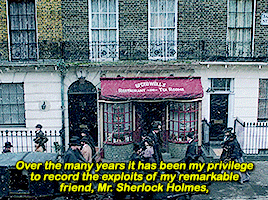
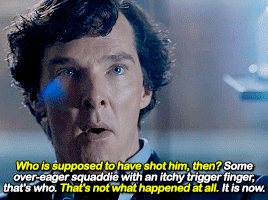
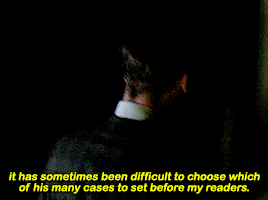


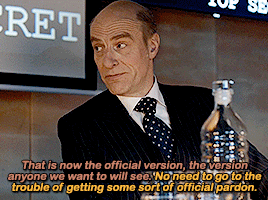
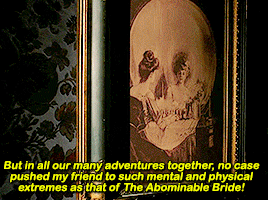
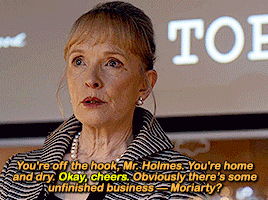
Looking Closer at How The Abominable Bride Foreshadowed and Can Be Used to Chronologically Decode Series 4:
In the opening of TAB, Sherlock imagines John narrating how as Sherlock’s biographer he picks and chooses which of his cases to present to the public, alluding to the nature of John as an unreliable narrator in the canon.
In the opening of TST, John writes Lady Smallwood and co. talking about modifying the footage of Sherlock shooting Magnussen and that their story will become the official one, setting up the nature of John as an unreliable narrator in series 4.
[Continue below the cut for more ➤]
See also: 10 Revealing Things From The Six Thatchers That Haunt You Late At Night, 10 Revealing Things From The Lying Detective That Haunt You Late At Night, and 10 Revealing Things From The Final Problem That Haunt You Late At Night. (#tw suicide)
Bonus: They’re not there:

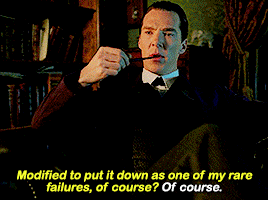

On John’s blog, he wears his heart on his sleeve. He adores Sherlock and clearly loves him even when he tries to downplay their relationship or play up his relationship with Mary. In his post about meeting Sherlock, he calls him “strangely likeable”, and talks like there’s life in for the first time in ages after multiple blog posts about how nothing happens to him.
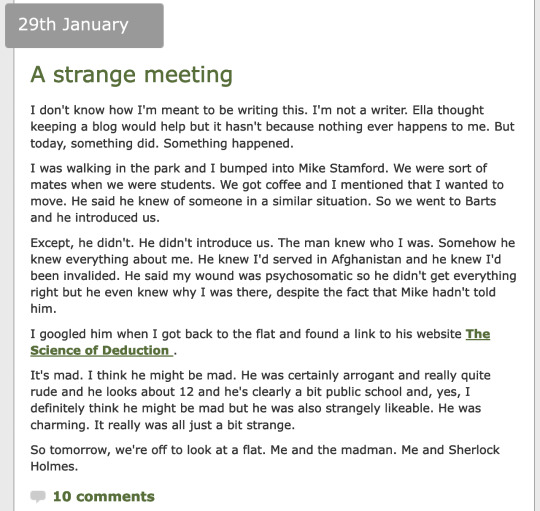
This includes how John thinks that Sherlock not only doesn’t love him back, but that he’s “spectacularly ignorant” about some things, including the way that he feels about Sherlock. How does the world’s only genius consulting detective not notice that? John is pretty forward about this is in one of his early blogs and first one about Sherlock’s cases.
He also says for the first time that he has to omit certain things in order to publish the story at all, echoing the nature of the original stories.
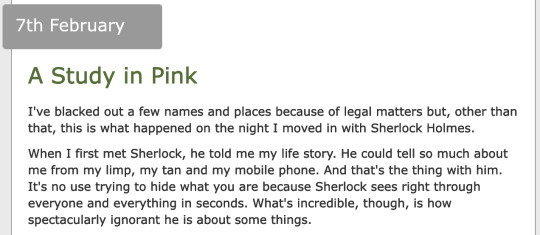
But Watson doesn’t say this in the opening of A Study In Scarlet; he straight-forwardly talks about his return from overseas and his meeting Sherlock Holmes, followed by the case that changes his life. It’s really in the other stories that Watson talks more about altering details, which is what the debate around his authorship revolves around.
It does provide an interesting comparison, though, the way that Sherlock hasn’t yet become the emotionless machine that the myth surrounding Sherlock Holmes is so obsessed with. He laughs, he dances, he expresses emotion alongside his deductions. The last line about Sherlock actually says, “Didn’t I tell you so when we started?” cried Sherlock Holmes with a laugh. “That’s the result of all our Study in Scarlet: to get them a testimonial!”
That changes with The Sign of Four. The opening of the second novel, following the success of the first, is about Holmes and Watson talking about the publication of their first case together.
Holmes: “Yes, indeed,” said I, cordially. “I was never so struck by anything in my life. I even embodied it in a small brochure with the somewhat fantastic title of ‘A Study in Scarlet.’ ”He shook his head sadly. “I glanced over it,” said he.
Holmes: “Honestly, I cannot congratulate you upon it. Detection is, or ought to be, an exact science, and should be treated in the same cold and unemo-
tional manner. You have attempted to tinge it with romanticism, which produces much the same effect as if you worked a love-story or an elopement into the fifth proposition of Euclid.”
Watson: “But the romance was there,” I remonstrated. “I could not tamper with the facts.”
Holmes: “Some facts should be suppressed, or at least a just sense of proportion should be observed in treating them. The only point in the case which deserved mention was the curious analytical reasoning from effects to causes by which I succeeded in unraveling it.”
Watson: I was annoyed at this criticism of a work which had been specially designed to please him. I confess, too, that I was irritated by the egotism which seemed to demand that every line of my pamphlet should be devoted to his own special doings. More than once during the years that I had lived with him in Baker Street I had observed that a small vanity underlay my companion’s quiet and didactic manner. I made no remark, however, but sat nursing my wounded leg. I had a Jezail bullet through it some time before, and, though it did not prevent me from walking, it ached wearily at every change of the weather.
As Sherlock Holmes becomes more of a text, the more Watson mentions about how he to change names, dates, details, or wait until certain people are dead until his stories are published, to protect international secrets and the lives of its characters. But it all started with Holmes and Watson in a flat, talking about how the romance should be suppressed.
In one of John’s early blogs he mentions a fortune cookie at the end, pulling a quote from The Valley of Fear:
“Everything comes in circles—even Professor Moriarty. Jonathan Wild was the hidden force of the London criminals, to whom he sold his brains and his organization on a fifteen per cent. commission. The old wheel turns, and the same spoke comes up. It's all been done before, and will be again. I'll tell you one or two things about Moriarty which may interest you.”

Except John says he think it’s going to be different this time. This version is going to do something different before. It’s going to admit that the romance was there. It’s not going to suppress it anymore by the end. But before it gets there, the story is also about how much, and what therein, the story is being altered in the first place. Enter series 4.
An important blog entry to understanding the mindset of Sherlock and John after series 3 is the last blog entry. To date, the blog is still suspended because if it continued the true nature and mystery of series 4, the answer would be spoiled.
It reads as follows:

Sherlock is openly disinterested and angry at the wedding to anyone who’s paying attention. And not without reason.
The ending of TSOT is one of the most devastating moments in the show. John and Sherlock both realize that neither of them wanted this marriage to happen, that they could have been together and in this passing look they know it’s moments too late after Sherlock realizes Mary is pregnant.
It happens and disappears in a moment.
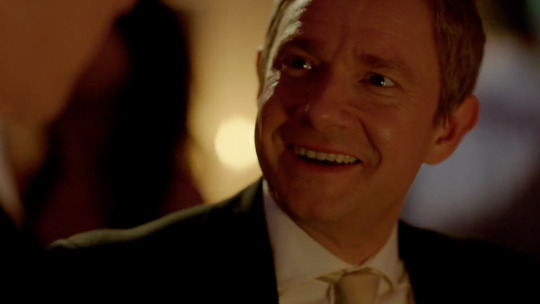
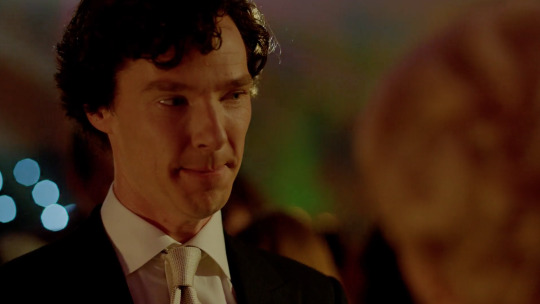
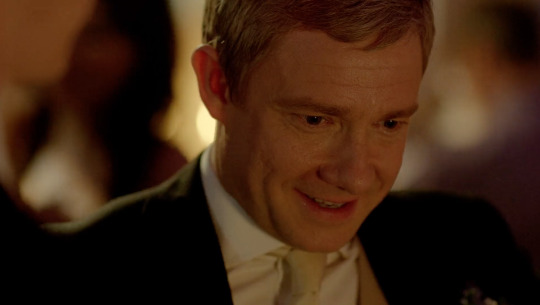
Sherlock leaves the wedding early. A month and one honeymoon later, John will be bursting to get out of his trainwreck of a marriage at every waking moment. He’ll bike to work. He’ll keep his bags packed. When he rejoins Sherlock in the flat he’s practically giddy, and then when he meets Janine and Sherlock explains that he used her later, he’s right back at wondering if Sherlock is capable of loving anyone or not.
And none of this is remotely mentioned in the blog entry. Sherlock takes over for John, foreshadowing that the next act of the show is about to retell The Casebook of Sherlock Holmes, which includes two stories entirely narrated by Holmes. HLV is one of the most devastating episodes of the show and it’s not on the blog at all. The public doesn’t know anything about what happened to them.
The next time we see John’s blog it’s going to say this. Absolutely nothing about their time gone, what Sherlock did or what John is going through. Of course, nothing about Mary either. He isn’t even typing anything like normal; he just fidgets his two fingers on the same two keys, and his blog isn’t on the screen. It’s a screenshot. Because what we’re watching is the blog itself.

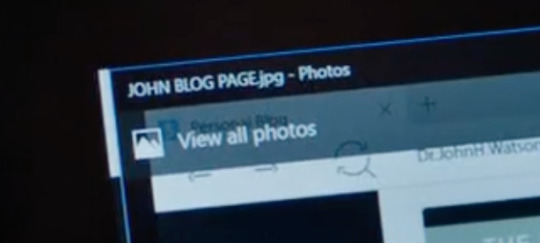
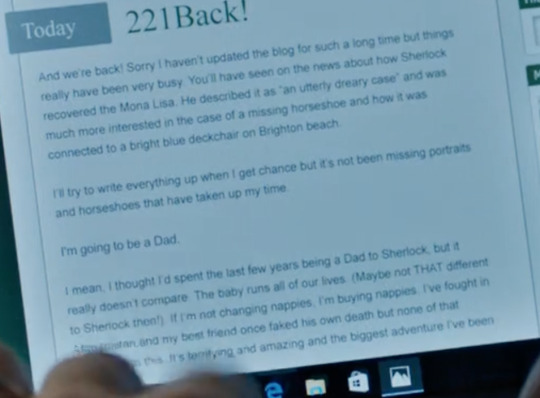
So the parallel starts thus:
After setting up his dream world and arriving at 221B Baker St., and a conversation with Mrs. Hudson about the way that John modifies people to be characters in his story, Sherlock imagines John giving the following narration
Watson: Over the many years it has been my privilege to record the exploits of my remarkable friend, Mr. Sherlock Holmes
The beginning is about putting up the front of John’s purpose and their relationship, calling Holmes his remarkable friend. In the next episode, John as the author takes liberties of his own in order to protect the people in it. He protects himself and Sherlock by covering up the true events of Mary’s death.

In TST, the opening scene is about doctoring the footage of Sherlock shooting Magnussen. With a bright projector light behind Sherlock’s head, the footage cuts out Sherlock putting the trigger as someone walks past the camera. This is being displayed as top-secret information as all of them sit inside a glass window room anyone could sit through.
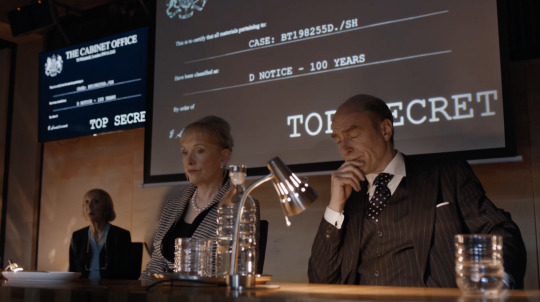
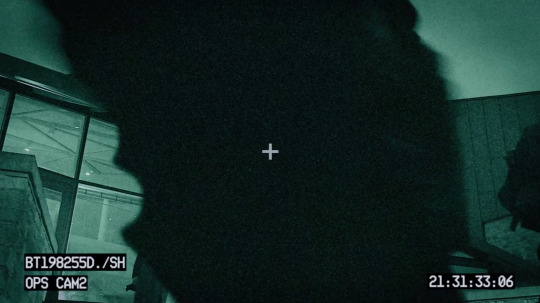
Sherlock and Mycroft describe how it’s different:
I see. Who is supposed to have shot him, then?
Some over-eager squaddie with an itchy trigger finger - that's who.
The over-eager shooter in this story has already conveniently been placed in the room. She has her own pen and paper, but isn’t writing anything down, which is her job as a secretary. It’s because a copy of that text, this conversation should exist, but it doesn’t, because Norbury doesn’t exist. Mycroft tells her not to write it down and put down it down, because once they’re beyond these walls, they must “never speak of it.” There’s also the meaning of Mark Gatiss being a stand in for the show’s writers, similar to the meaning of when John finds the dog’s bones, a correlation to Emelia Ricoletti’s grave being a switch.
It also creates a connection between John the author and Norbury. She’s the one with the pen and she’s going to take the fall, but John is the one who really shot Mary.

Back in TAB, John continues about how he picks and chooses cases to tell:
Watson: it has sometimes been difficult to choose which of his many cases to set before my readers.
That includes, as far as we know right now, the entirety of HLV. He leaves out Magnussen, Mary shooting Sherlock, Mary’s past, and Sherlock shooting Magnussen at once. It’s not just about the cases though, it’s about other things that John leaves out of his story.
In Sherlock’s mind: it’s not just smaller things that John says, like Sherlock being “spectacularly ignorant” about certain things and wounding his ego or embarrassing him, it’s that John never picks up on how much Sherlock loves him. John is hiding the true nature of their relationship from the world because he doesn’t see all the deductions of how much Sherlock loves him back.
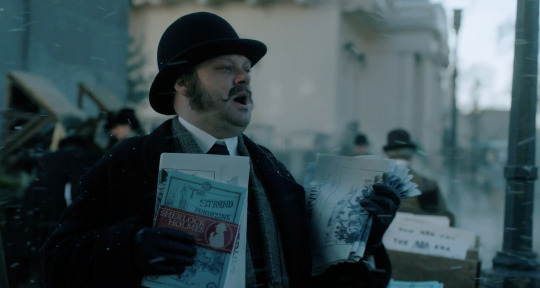

Immediately after the credits in TAB John is praised by for the success of the Adventure of the Blue Carbuncle by a man selling Sherlock Holmes branded content in The Strand Magazine, asking if “there’s going to be a proper murder next time.” He inquires if Sherlock is in the carriage at sight of his profile, the same one printed on the paper he’s carrying, and John dismisses him at Sherlock’s behest. That particular story is from the first short story collection, after A Study In Scarlet and The Sign of Four, and before Sherlock’s presumed death in The Final Problem.
“Remarkable. How did you do it?”
“We have some very talented people working here. If James Moriarty can hack every TV screen in the land, rest assured we have the tech to doctor a bit of security footage.”
John isn’t just talking about how easy it is to doctor footage, but that it’s even easier for him to do as a writer with words. He doesn’t need any government technology to alter the story. All he needs to do is the essence of this scene – lie and invent. Like when John invents the story about Eurus in order to lie about what happened to him where he has a pen and paper.
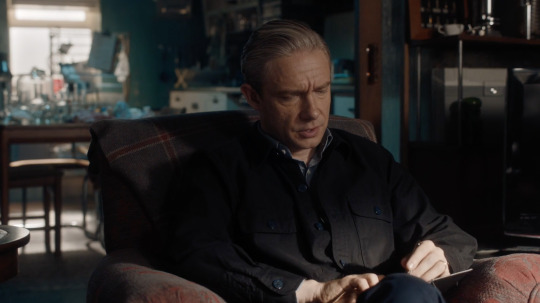
Watson admits the reason he has to do this back in TAB:
“Some are still too sensitive to recount, whilst others are too recent in the minds of the public.”
At the end of the story, Sherlock will ask to make sure that Watson modified the story, to “put it down as one of my rare failures, of course?” The story was progressing like a normal adventure until Sir Eustace’s murder, and then the entire second half of the story was omitted. Sherlock helped Lady Carmichael get away with murdering her husband. He broke his vow, it’s one of his “rare failures”. Sherlock is imagining their marriage in order to try to predict what would happen in the near future and what danger John would be in.
Mary is the case and she becomes the case the next episode. It’s at this point in TAB that we see a shot of the knife in the mantle – connecting to TLD when Mary’s case, the message tied to the dagger, or the case on how to save John, is the one Sherlock still hasn’t solved. The knife is still there in the fake ending of TFP. John thinks he still hasn’t solved it and that’s why he was shot at the end of TLD.
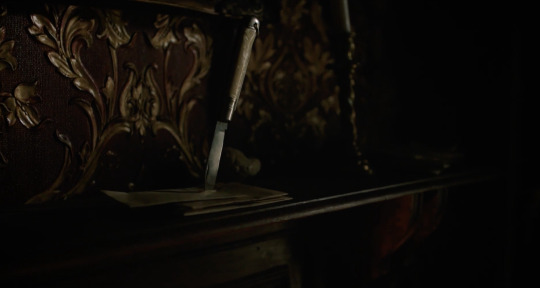
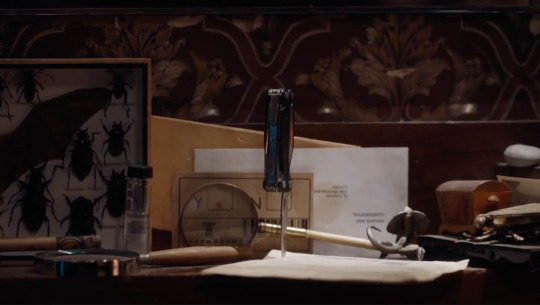

Mary is Sir Eustace with the dark past coming back to haunt her. Mary is the post-humous revenge Sherlock alluded to, the vengeful bride who faked her death to kill her husband, the figure of Death in the Samarra story, and half the ultimate villain – but some cases are still too sensitive to properly recount. Moriarty isn’t back. No, no, no. He’s definitely dead. He planned his revenge on Sherlock five years ago by filming a bunch of reaction gifs and jiving against the glass with Eurus like a snake.
The next episode, Mary’s past comes back to haunt her, and Sherlock breaks his vow. One of his “rare failures”. The over-eager shooter is hauled away as the projector lights the back of her head.


Mary’s death isn’t the only case that John covers up, however. He manages to do that relatively consistently. Even with how on the nose it is, the audience was convinced. The most convincing case is the one that John doesn’t show at all; the cover-up of his own death.
In TST, it’s clear this is about getting away with murder:
That is now the official version, the version anyone we want to will see.
No need to go to the trouble of getting some sort of official pardon.
Lady Carmichael doesn’t have to bother with a pardon and neither does John. His cover-up story, The Final Problem, is an entirely invented entry in the great Sherlock saga, using the name of a real one as a red herring, ending their story and establishing normalcy so no one will know what happened to him next. Series 4 is what happened, officially. But it’s not the truth. John has modified the truth. The romance has been suppressed.


John can’t tell that story because he has to make it convincing enough to draw Mary into the open; he doesn’t want to go to the trouble of getting a pardon when he has to face her again. This has to be the version everyone believes so that when it’s revealed that John committed suicide, everyone believes that too.
John has let his insecurities, self-hatred, and suicidal ideation leak into the subtext of series 4, so that when the news gets out about what really happened, and that the last story in particular was a total fabrication, people believe the secret story hidden beneath the true one. Suddenly the decline of hi stories becomes the tragic tale of a man losing his way and taking his lie. The story ends on a low note. “It’s gone a bit downhill, hasn’t it?” And it is emotionally true, but it’s all part of John’s bigger plan to fake his death.
When Eurus as Faith gives Sherlock the note about Culverton Smith she writes one story on the surface, the one that Sherlock deduces, but hides another message underneath that he doesn’t see until it’s too late. This is the case he didn’t solve.
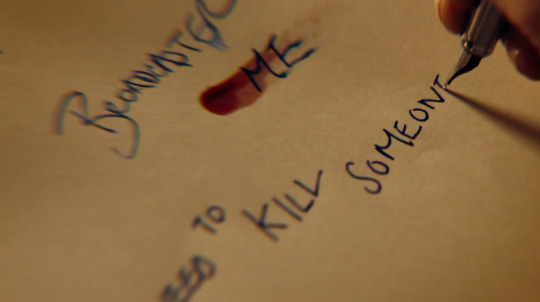

This is what John’s story is: one text subsumed by another bubbling just beneath its surface. When John’s original story falls through because of what happened at the end of TLD, darkness completely overwhelms his story in TFP. Sherlock is drowning in it until he ties a nice bow on the ending. One coverup hiding another coverup. That’s how you sell a big lie; you wrap it in the truth to make it more palatable.
One of John’s blog entries has a picture of the knife stabbed into a clue board. Sherlock figured out that the victim faked his own death.
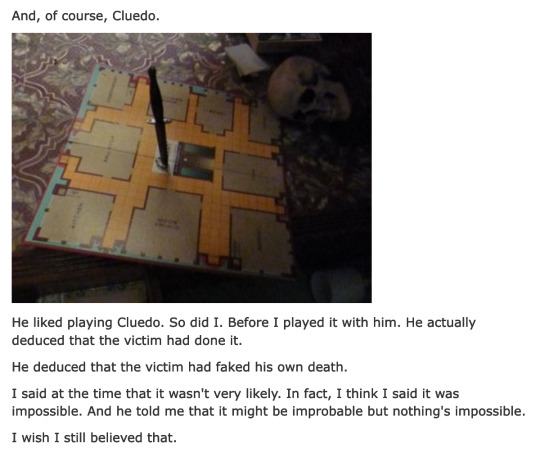
TAB foreshadows the lengths John goes to:
But in all our many adventures together, no case pushed my friend to such mental and physical extremes as that of The Abominable Bride!"
Sherlock is pushed all the way to the predestined end of the story, clinging to life at the Reichenbach Falls with Moriarty punching him down. It’s only when he decides to let John in emotionally that he appears, foiling him easily, kicking over the falls like he isn’t a threat at all. Because he isn’t when they’re together and they openly love each other.
John doesn’t have the same confidence. John thinks that he can’t avoid Samarra – that even if he fakes his death, that happy ending he invents at the ending of TFP is the closest to happiness that he’s ever going to get. Sherlock has more confidence in John and what they can accomplish together. “I’m a storyteller. I know when I’m in one.” The real John knows it too, but he can’t see the same ending Sherlock does if he still doesn’t know Sherlock loves him back. John’s ending is a dark mirror and denial of Sherlock’s hopeful vision.
Nothing has pushed John to such mental and physical extremes as that of the abominable bride. Mary faking her death, returning to manipulate and gaslight him, and trying to get him to commit suicide to burn Sherlock’s heart out of him forever is the worst thing that John’s ever been through. The most trying case in his career working with Sherlock. Faking his death, however, isn’t the end. Because the whole point in all of this is to outsmart Mary and Moriarty, drawing them into the open so John can make his move.
Smallwood: “You're off the hook, Mr Holmes. You're home and dry.”
Sherlock: “OK, cheers.”
Smallwood: “Obviously, there's unfinished business. Moriarty?”
For Sherlock, his unfinished business is Moriarty. For John, it’s Mary. They’re going to have to work together to finally defeat them once and for all – and they can only do that once they both know the truth. Nothing can stop them. Then the spoke will turn, and the world will have something new.
But for now, the truth has to be modified. The romance has to be suppressed. Until the world is convinced John is dead and he’s in the clear.
“That’s not what happened at all.”
“It is now.”
#sherlockedit#tjlcedit#johnlockedit#sherlock bbc#tjlc#john watson#sherlock holmes#mary morstan#vivian norbury#meta#the abominable bride#the six thatchers#edits#gifset#gifs#looking closer at tab timeline#television#john's blog#series 4
90 notes
·
View notes
Text
Hadestown
First off Hadestown was phenomenal. I legit almost cried at the end; even though I knew there wouldn’t be a happy ending, the musical did such a good job of creating and then destroying hope for the characters. It was probably the most religious experience I’ve ever had doing laundry, so props to that.
All of the songs were bangers, and the casting of the voices was really well done. Orpheus makes sense as a pretty boy with a gorgeous falsetto, Persephone sounds world-weary but has the capacity to harken back to a time of youth and innocence, and Hades sounds menacing without totally getting lost in the maniacal villain thing (except for the part where he yelled about the electric chorus that was a little much).
I love how this version made explicit the parallels between Hades/Persephone and Orpheus/Eurydice, and also how this version gave both women way more depth. This not only fleshes the story out and makes it feel a lot less misogynistic, it also just makes the story better. In the original story, Orpheus was just a stupid musical fuckboy who couldn’t follow orders for more than two minutes. Whereas in this version, while I was still like “why would you look around?” his doubt makes so much more sense. She left him once before, and so its natural and human for him to doubt her loyalty now.
At the same time, Orpheus turning around is extra tragic for Eurydice, who left him because of his inability to provide for her. We get the impression that Eurydice, who was doing all of the hard work, felt neglected materially but also emotionally — he was more focused on music than her. By coming to save her, he proves his love, but his inability to do the hard thing and not look back proves that he hasn’t really matured. The same impulse that led him to neglect food and shelter for his music also preventing him from following Hades’ instructions. So really they couldn’t be together, even if Eurydice had escaped — nothing had changed, they were caught in a cycle.
That cyclic feeling to this story is obviously thematically in conversion with Hades and Persephone, which is so cool and deepens the story. It also redeems the musical as a musical. From experience, it’s hard to practice and perform a musical over and over again if there is no sense of redemption at all, and if you don’t fundamentally enjoy the story, the characters, and the themes. The closing song, with Hermes talking about how it’s the same song, and we sing it over and over again, hoping it’ll change even though we know it won’t, is conversation not just with the nature of myth and storytelling, but also the nature of performance.
Myth and stories are told over and over again, and what Hadestown does it what all good retelling of myth do — they make the same story feel alive and vital again. I knew there wouldn’t be a happy ending, but I felt the tragedy as is if it could have ended another way. That ability to imagine what could have been is, according to Hermes, Orpheus’ true gift. Orpheus is generally just a metaphor for all artists, so it’s kind of also a statement about all art.
What makes this link compelling is the fact that, for the performers in the musical, the have to literally tell this story over and over again, and in order to make each performance good that have to basically trick themselves into thinking it could end differently. That’s just what performing is, being able to replay these emotional beats over and over again and keep them fresh. So Hermes, who addresses the audience and is a really cool meta-textual character (which is stylistically very resonant with the way that ancient Greek poems started with 4th wall breaking invocations to the muses), is also making a commentary about the play itself. The fact that this is a performance is called out, but rather than weakening the story is strengthens it — it calls attention to how this story is an eternal loop of hope and pain, just like the seasons are eternal. So it explains the purpose of the musical in the same way these myths were explained in the past — they both do explanatory work about the world, and the cyclic nature of the seasons, and of love and loss. It’s just more abstract than literal explanatory work (which is probably more accurate to the ancient view of myth, honestly, than an overly literal one).
Hadestown also does what ancient myths did, which is reify abstract concepts in a way that makes reasoning about these concepts easier. Hadestown plays up Hades’ relationship with wealth, and so to me a lot of this reads as an interesting critic of capitalism in the face of environmental destruction. Hades’ constant industrial expansion is destroying his relationship with Persephone, who is emblematic of the natural world. The moments of beauty in this play are all related to nature and the natural — most poignantly, the description of Hades coming to the Persephone in “her mother’s garden,” and sleeping with her (which is an incredible finesse, mixing Christian and Greek spirituality pretty flawless and concisely, wow). A parable about success destroying a marriage that started beautifully is a perfect metaphor for the destruction of the planet by human beings that are uniquely situated to enjoy and appreciate its beauty. That’s the kind of thing that myth is excellent at, casting abstract struggles in personal terms that make those abstract struggles real.
Also, the whole wall thing is even more effective today than in 2016, and like makes the whole Hades=capitalism even more interesting and powerful
1 note
·
View note
Text
Myth, Sonnets, and Immigration: Susan Glass Interviews Broadside Winner Armen Davoudian
Susan Glass is our blogger with interviews of fellow poets, literary journeys, and all things poetical. In this blog post, she talks with Armen Davoudian, who won the 2019 Slate Roof Glass Poetry Broadside Prize for his poem "Ararat."
Armen Davoudian is the author of Swan Song, which won the 2020 Frost Place Chapbook Competition. His poems and translations from Persian appear in AGNI, The Sewanee Review, The Yale Review, and elsewhere. He grew up in Isfahan, Iran and is currently a PhD candidate in English at Stanford University.
S G: Thank you for talking with me today. In “Ararat,” I hear and read a recurring theme in your poetry, the tensions between a myth and its various retellings, or between a myth and a reality — tensions underscored by parallel tensions within a speaker. In "Ararat," we have the tensions between the raven and the dove, and a shadow and an image almost touching. There's also the dove's olive branch that splinters, and can never be carried back.
It's hard to return home after absence, to find ourselves or our homes exactly as they were before we left. Were you thinking about these tensions when you wrote "Ararat," and how they play out in your homeland and in your life?
A D: Thanks for commenting on the tension between myth and reality. Ararat, the mountain, is an important symbol in Armenia, and for Armenians. I am ethnically Armenian, so it's been a present image since childhood. The mountain itself used to be in Armenian soil, but now it's in Turkey. So there's symbolism and tension around it. Ararat is traditionally seen as the place where Noah's ark landed. I've always been interested in that story and the story of the flood as a kind of allegory for immigration. We leave one world behind, and wash up on the shores of a new world.
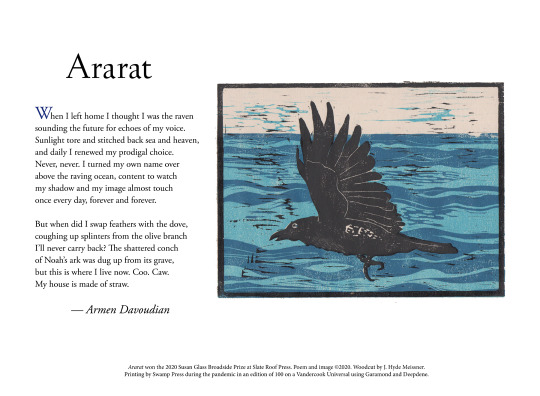
Purchase the broadside "Ararat" at http://slateroofpress.com/contest2019b.html#poems
S G: The speaker in "Ararat" identifies as "prodigal."
A D: Right. The Prodigal Son is another Biblical story, and in that story he does go back home and is accepted with open arms. But maybe that's one of the tensions between reality and myth. In the real world you never really can go back. The place has changed and you have changed.
S G: "Ararat" is a sonnet, as is "Black Garlic," the poem that opens Swan Song (see https://bullcitypress.com/product/swan-song-by-armen-davoudian/).You handle the sonnet form with flexibility, and delightfully surprising word arrangements. What intrigues you about the sonnet?
A D: I find poetic forms musically appealing. With the sonnet, there's an asymmetry between its two unequal halves that attracts me. The sonnet was a courtly love poem that originated in the 13th century. But I feel that it's perfectly suited for the story of immigration and displacement because of that division in the middle. There's also a long tradition of the political sonnet going back to Milton. I'm interested in how this tiny form can fit such huge personal and political subjects within itself. Big ideas and feelings in a small package.
S G: Yes. It welcomes and forces our attention on to the issues at hand because of that paradox.
A D: I think so. One of the distinguishing characteristics of poetry is its brevity, and brevity as possibility. It's not a shortcoming, it's a possibility. Brevity allows you to do different things. It's transferable. It's portable. You can hold it in your mind and in your mouth. You can't memorize a whole novel, but you can memorize an entire sonnet.
S G: What you are saying about the power of a sonnet's brevity reminds me of how Seamus Heaney could take the immensity of the sectarian violence happening in Ireland, and fit it into the tiny sonnet form.

A D: Heaney’s sonnet sequences have been really important to me. I admire how he fits a family story, the sequence about his mother, for instance, into this tiny form. And I like the way he fits food into his work, the way food is so sensual for him, like his references to oysters and potatoes — pregnant with meaning, but in a way that doesn't cancel out its physical properties. You can still taste it even though it stands in for a whole range of meanings.
S G: Attention to food comes through in your work too. I'm thinking about "Wake-up Call," and the tender attention you pay to tea-making, and breakfast preparation, and the speaker who is both present and yet absent. I feel as I read this poem, a lifelong homesickness, longing, tenderness.
A D: Thank you.
S G: I know that you are a fluent speaker, reader, and writer of Persian, Armenian, and English. This allows you access to a plethora of images, metaphors, and mindsets. In which language do you compose? Dream? Are some of your poems better suited for one language than for another?
A D: I grew up in a small, diasporic Armenian community in Iran, so I learned Armenian first, even though the language of instruction in school was Persian. And I learned to read and write in both Armenian and Persian. But now I write exclusively in English. I also translate from Persian, and more recently from Armenian. I'm visiting my parents in Los Angeles right now, and here I speak Armenian. Persian has become an almost exclusively literary language for me, and these days I only read it or write it. So I sometimes feel out of touch with it as a living language. I'm comfortable living in and with English now, though I occasionally must think about what is the correct preposition (at college, on campus). But I think it helps sometimes to be a little alienated from what you love, or from the tools you're working with. It helps sometimes to see them as an outsider.

S G: So as you move through your daily life, what language are your thoughts in?
A D: Mostly in English. I'm in grad school, so I'm thinking about grad school stuff. But if I'm cooking a Persian meal, I'm thinking about the ingredients and the recipe and the preparation in Persian. And if I'm remembering something my granddad said, that will be in Armenian.
S G: Several of your poems address political strife using direct, emotionally engaging language that insists we pay attention. You make us feel what too many news blasts and too much information would rather smother. I'm thinking of your lament about former president Trump and the many children stranded at the U.S. Mexican border. You write: "they are wrapping them in Mylar / and putting them to sleep where they used to house ammo." Then you juxtapose the word "ammo" to a mother calling, "te amo, te amo." You make what's political human. How important is this to your writing, and does it figure in your current projects?
A D: Thank you for asking that. We live in a time of bombardment and desensitization. You read these things in the news and at some point they stop moving you. But I don't think this applies to political realities only. When I think of one of my favorite people ever, my grandfather, and the fact that he's dead, I can say that and it doesn't stir any kind of emotional response in me, until I put it in a poem that does excite emotion. So I think that's how I feel about the political reality too. Unless you're in it, it's distant. I feel like it's our job as writers to make it present and make people feel it. One of the ways that I try to do that is by pointing out those weird linguistic coincidences (“ammo” and “te amo”). We have this tender confession of love on a mother's part, and the exact opposite in that "ammo."
S G: I listened on YouTube to a presentation called “Don't Look Away,” a literary series sponsored by the International Armenian Literary Alliance. You participated as a reader. I imagine you are actively involved? Can you share a bit about the organization and its work?
A D: Yes, I’m a member of IALA. It was founded recently as an organization for Armenian writers throughout the world, of which there are many, because the Armenian diaspora is huge. A lot of Armenian writers live outside of Armenia, and it's been a great way to connect with them. They offer a mentorship program for younger Armenian writers, too.

S G: Would you like to talk a bit about the work that you are doing at Stanford? Are you writing? Are you teaching? What is it like to balance your writing and your studies?
A D: I'm doing a PhD in English that does involve teaching. I'm studying modern poetry in English mostly, and I'm writing my dissertation on a literary device called metanoia, which means self-correction. It's a rhetorical term for what some poets do where they'll say one thing, and then retract it, or rephrase it. It can be something as simple as writing "the sky is light blue," and then writing, "no, it's dark blue." But instead of deleting one of these assertions, you keep both of them in the poem. This doesn't happen just on a lexical level. It happens more generally when poets doubt themselves or second guess themselves.
And I find this happens to me as I write poetry. I tend to have a hard time making my mind up about things. So much in the world is ambivalent or ambiguous, and I want to know things clearly as I write, but of course that can't always happen. So in some ways, studying this device, metanoia, has been helpful. It helps to know how other poets handle this problem of trying to write out of uncertainty.
S G: Yes. We'd like to be able to move as we write from uncertainty to certainty. But too often it feels as though we are writing into deeper uncertainty.
A D: One poet whose work I've studied intensively who I think exemplifies this self-doubt is Elizabeth Bishop. Bishop is often seen as this poet who made perfect little lyric poems. But I don't think we have truly grasped how loose and free and prosaic they are.
S G: You are reminding me of her poem, "Manners."
A D: Yes. She and her grandfather are riding in a horse-drawn wagon, and her grandfather says that she must say hello to everyone they pass. It’s the polite thing to do, even though I think that as a lesbian writer, she would have a lot to disagree with in terms of what is “mannerly” to do and what isn't, what is accepted and what isn't. But at the same time, she sees her grandfather's manners as one of the ways he manages to be nice to people, to keep his footing in the world. But she feels really divided about it, and the poems issue from that sense of division, and self-division. That's been instructive for me.
S G: Yes. That speaks to your work. I'm thinking particularly of your poem, "Coming Out of the Shower." It's a poem rich in double meaning ("mama, I'm coming out") as in coming out of the shower and coming out as a gay man. But I also love its sensory richness, and how the speaker says that he's using his mother's shampoo, and will smell like her for the rest of the day.
A D: I use Dr. Bronner’s shampoo usually, which smells like mint. But at some point it just starts smelling like nothing because you get used to it. Other people may smell it on you, but you can’t — not anymore. So using someone else’s shampoo is suddenly a shock to this senselessness. It's almost a perfect metaphor for poetry, how we get used to the world and to language, to the point where they cease to move us, until and unless a poem shakes us out of it
S G: Are you teaching right now?
A D: I'm putting together a proposal for a course next year on the sonnet. I'm excited about that. I want us to look at the form from Petrarch to Terrance Hayes. I'm interested in how the sonnet has survived many centuries to work so well today.
S G: Can you describe your own writing process and your writing space?
A D: I've moved so often — I guess that's part of being a graduate student. I try not to attach myself to a particular place or desk or chair. I don't want to feel like I have to wear a certain pair of pants in order to write. I try to write every day, first thing in the morning, for 2 hours, with coffee. I have a set of books that I keep with me, Seamus Heaney's books among them. When I get stuck, I read a poem by someone whose work I admire, and the flow usually starts again. Some, like Gertrude Stein, are experimental poets and writers who provoke me. I don't write like they do, but they help me get started. They make language opaque again. I notice it again. It's there to be worked with and through.
S G: Whose work do you enjoy reading?
A D: I think I became sure that I wanted to be a writer when I read Proust, first in Persian and then in English. I appreciate his sense of the importance of memory to life. I also gain from him a sense of what an artist's life looks like. I appreciate the importance of erotic tension in his work – desire, love, jealousy. For similar reasons I am drawn to James Merrill's poetry, his love of form, music, memory, and childhood. Then there is the poetry in Persian. The Asian American Writers’ Workshop recently compiled a list of 100 works of Persian literature in English (https://aaww.org/100-essential-books-by-iranian-writers-poetry-hybrid-works-anthologies/). I've always wanted to teach a course on the poetry of exile, so I read poets whose work addresses that.
S G: What are you working on now?
A D: I'm working on my first full-length book of poems. It starts with a crown of sonnets called “The Ring.” My dad had to get his wedding ring re-sized, but he ended up buying a new ring and he gave me the old one. The sequence is about that exchange, that passing down of a memento, and what that means since I probably won't have the kind of traditional marriage that ring was made for.
S G: Has it been challenging or ambivalent or tender to talk to your mom and your dad about being gay?
A D: Yes. They had such a different upbringing in a different place, but still they've been very loving and open. Sometimes I feel like it's taken away one of the tensions that used to drive my poetry!
S G: Will some of the poems from Swan Song find their way into your new book?
A D: About ten of them will. This new book has two long sequences of sonnets, so I'm hesitant to put in any more.
S G: Thank you so much for talking with me today. Is there anything I haven't addressed that you'd like to talk about.
A D: Just thank you so much for the beautiful broadside! My parents were really happy to have it. My mom has framed one and it's in their living room. Thank you for this conversation.
S G: Thank you! I look forward to hearing you read on April 12.
0 notes
Text
Girls made of snow, language made of thorns, and putting ourselves back in the narrative
I’ve had some ideas swirling around my head ever since I finished reading Girls Made of Snow and Glass by Melissa Bashardoust that condensed while I was reading Leigh Bardugo’s short story collection The Language of Thorns, so I want to talk about it a little.
It started with the realization that Girls made of Snow, while it is a Snow White retelling (or perhaps better called a reimagining), completely leaves out the whole seven dwarves part of the story. In my review, I pointed this out as something I liked — the story didn’t need to sidetrack there, and it kept us focused on the real core of the story: Lynet’s relationship with her stepmother, Mina. Lynet being Snow White, Mina is the Evil Queen.
The book alternates chapters between Lynet’s present day and Mina’s journey from the daughter of a sorcerer to the bride of Lynet’s father, making Mina the second main character. This is where the book’s “feminist fantasy reimagining” tagline comes in. The point of Bashardoust’s story is to explore the stepmother-daughter relationship and how they could come into conflict without it being about who is the fairest of them all.
The point of tension Bashardoust goes for is about politics and power, a much more satisfying reason than “well, women get angry when another woman is prettier, that’s all”. But the framework of Snow White also gives her plenty of room to work with how women’s appearances and age are seen and judged. What if Lynet’s beauty binds her to her dead mother in a way that strangles her, while Mina struggles with knowing her beauty gains her what respect she commands and aging could steal it away? The commentary that emerges isn’t new — I think we all realize how damaging the value placed on women’s appearances is — but using the cultural touchstone of Snow White makes this version powerful. It’s probably my favorite thing about the book, even above giving Lynet a female love interest, which is something we’re going to circle back to.
Consider, for example, Mina’s power to control glass. The idea of giving a woman who is forced to care about her beauty the power to make looking glasses into weapons (the power to control what controls her in the original story) has an inherent message that’s only as powerful as it is because the iconography of Snow White is so well known to Bashardoust’s audience. That’s why she can give us a handful of Snow White parallels and then leave out one of the biggest story points and still have us understand the commentary she’s making. The messages are built in; she doesn’t have to build them first in order to tear them down. They’re already there.
Because we know fairytales. Reference Cinderella’s slipper, Sleeping Beauty’s spindle, or Snow White’s glass coffin and you can easily call up a whole set of values, assumptions, and feelings with hardly another word. Our reservoir of shared stories (consider also the Greek myths) is essentially a resource for writers who want to make it obvious they’re subverting our cultural mores. It’s shorthand for “Society is fucked up, hold my beer and watch this”. It’s a way of making subtle commentary in an... obvious manner? It’s a unique way of balancing obvious and subtle; it’s the equivalent of roadsigns you only need to glance at to know that you’re driving towards; it’s an ocean of potential stories waiting to be overturned. The ability of writers to take any of these classic objects or situations and drop them into their stories and immediately add a whole slew of connected ideas is fascinating to me. It’s magical.
Which brings us to The Language of Thorns. The collection isn’t exactly labeled “retold/reimagined faiytales” anywhere (it’s a collection of stories that would be read to children in her Grishaverse), but Bardugo says in her author’s note, “That unease [with the ending of Hansel and Gretel] has guided me through these stories […] The more I listened to that note of warning, the more inspiration I found.” The stories indeed feature a retelling of Hansel and Gretel, a prequel to The Little Mermaid, and a reimagining of The Nutcracker.
In one of my gleeful posts as I read the book I ended up gushing that “by writing her own fairytales [Leigh Bardugo] gets to play with our expectations, because we get all the references to our own stories — gingerbread houses, labyrinths holding monsters, clever talking animals — so we have a false sense of security that we know where it’s all going, and then she treats the ending of the stories more like writing a novel and adds more complexity than we expect of stories like Cinderella or Hansel and Gretel” and yes I’m going to quote myself in my own essay-thing because I still think that was a good reaction.
The first story of the collection, Ayama and the Thornwood, makes Bardugo’s intentions clear when the main character literally retells three different tales with improved endings to satisfy the boredom of a beast who finds fairytales too predictable and unrealistic. So it’s, you know, meta.
There’s an excitement there, in reading the fairytales you (sort of) know with their seams torn open to make room for you, stitched into something new. In Bardugo’s stories, the Grimm brothers’ female villains are reexamined, blame is shifted, new ideas are put forward (not all connected to feminism, but the treatment of Hansel and Gretel and The Little Mermaid’s villains, and the creation of a new female villain in Bardugo’s The Too-Clever Fox, make a clear argument about the roles women are given in our fairytales).
This is a nice connection to Girls Made of Snow and Glass: the deeper treatment of women’s motives that make familiar tales new. I’m almost disappointed The Language of Thorns didn’t include a Snow White story to compare and contrast with.
But let’s circle back to Lynet’s love interest in Girls Made of Snow: Nadia, the castle physician. It was the promise of a gay Snow White that drew me to the story, and it’s still a wonderful aspect of the book. Putting women into slots reserved for men is almost always a breath of fresh air, especially when the rest of the story isn’t then adjusted to keep it heterosexual. One reason is because it eliminates the “man always saving the woman” aspect by making it one woman saving another — consider Nadia filling the prince’s role in awakening Lynet from her coffin, and the female river spirit of Little Knife winning the hand in marriage of the beautiful girl. But of course the major reason is getting to see non-heterosexual people in fairytales.
We don’t get this when we’re younger. At least, I didn’t, though I hope that starts changing for kids now. So to read stories where the women love women, where men can love men and women (to reference The Language of Thorns specifically, since we get a bisexual protagonist in one story and a wlw couple in another) feels like — to quote a certain musical — putting ourselves back in the narrative. I can’t change the stories I was read when I was little, but I can (we all can) read the stories that are slowly but surely filling up goodreads’ “lgbt retellings” shelves.
(Possibly it’s weird to use the phrase “putting ourselves back in the narrative” when I’m actually not sure about either author’s sexuality, but this is mostly about the perception of queer readers getting queer retellings anyway. If I read Julia Heslin’s Once more recently I would have loved to add something about her version of reimagining queer fairytales but it’s been a bit too long for it to be fresh in my mind.)
“I put myself back in the narrative” isn’t a flawless parallel for other reasons as well. After all, the whole point about “Eliza and the narrative” is that she took herself out of it in the first place, and then put herself back in. The first action was as much an act of power as the undoing, and queer people never took ourselves out of fairytales in the first place (I don’t think that’s really a thing that happened, anyway). But I couldn’t get that line out of my head as I thought about this, so it seems like the right way to end this ramble.
When we put ourselves back in our narratives, when we tell our touchstone stories with us included, it’s automatically a powerful statement that we belong there. So yes, while this has mostly been me trying to figure out how to say “we all recognize fairytale elements at such an essential level that it gives authors an amazing tool to work with to make their works more nuanced and gives them a basis to build social commentary on”, I want to end this with the point that works created with these tools, narratives constructed on these foundations, are so liberating and important and wonderful because they not only make use of our childhood tales but tell us we belong there.
#girls made of snow and glass#The Language of Thorns#melissa bashardoust#leigh bardugo#lgbt literature#feminist literature#fairytale retelling#the rambles of an overbooked worm#purronronner#allfortheloveofabook#ghost-with-the-toast-babe
417 notes
·
View notes
Photo


Caitsbooks Reviews: To Kill A Kingdom by Alexandra Christo
I went into this book knowing only the very basics of it. I didn’t even know it was a Little Mermaid retelling until a quarter of the way through the book. Either way, it was absolutely epic and I loved every word.
To see my review on Goodreads, click here!
Overall: 5/5 Stars
Characters: 5/5
Setting: 5/5
Writing: 5/5
Plot and Themes: 5/5
Awesomeness Factor: 5/5
If you don’t feel like reading this long review, here is my review in a nutshell:
This book has a breathtaking writing style, diverse and interesting characters, and an amazing world filled with myth and magic. I would recommend this to any fantasy fan, or anyone looking for a dark twist on a classic.
“They celebrate love as though it’s power, even though it has killed far more humans than I ever have.”
To Kill A Kingdom is a loose retelling of The Little Mermaid, following Lira, the daughter of the Sea Queen, and Elian, prince of Midas, pirate, and ruthless siren killer. Lira has developed a name for herself as heir to the throne and siren princess, the Prince’s Bane, for every year she kills one prince and steals his heart. Elian has made it his life’s goal to end the Prince’s Bane and sirens altogether. When Lira is cursed by her mother, she is made human and told to bring back the heart of the siren killer, but first, she must win over his trust.
This book takes place in a fantasy world filled with various kingdoms, each with their own myths and legends. All the lands that the characters go to are extremely well described, and you can just tell that they hold a rich history, even if there isn’t much time to delve into them. No place they travel to feels underwhelming, each location is just as fascinating as the last, but for entirely different reasons. The mythology was also really well written, and easily understandable while not being simple or cliche. Also, there are a lot of fascinating magical objects that I just really wish I could have in real life (like Elian's compass, or even Elian's knife)(don't ask me what I would use the knife for).
The writing style was probably my favorite part of this book. Alexandra Christo writes so beautifully, her descriptions vivid and dialogue entertaining yet true. I can’t wait to see what else she does because she hooked me with this book. She managed to make the simplest lines feel poetic and beautiful. It was mesmerizing.
The characters in this book were also amazing. I love morally gray characters, and this book has a lot of them. While they do develop, there is no urge for them to be perfect people, because they aren’t and they don’t care to be. Lira and Elian were great protagonists, their secrets adding to the suspense, and their overall growth subtle yet clear. Lira is such a strong character. Having dealt with abuse and manipulation, her arc was amazing to watch. Elian was also great. He’s cocky, noble, but also has a ruthless side. While he cares about his family and his kingdom, he also wants to live his own life and be free (something that usually feels cliche in fantasy right now, but with him, it felt genuine and understandable). Also, he’s so sarcastic and I live for it. The side characters were also great. The cast was very diverse, and the characters all well-written and interesting on their own. They were all likable and just so fun!
The relationship between Lira and Elian was another fantastic part of this book. Most YA books have a cliche love story (which I almost always adore), but I love how their story isn’t rushed or really on the forefront of the novel at all. It's just as subtle as their growth, and when it does happen it feels right, not in-your-face and forced.
To Kill A Kingdom is a Little Mermaid retelling, but it's so different. While there are a lot of parallels, it really is its own story. I absolutely love retellings, but I do know when they follow it by the letter, it can get boring. In this book, Alexandra Christo takes what we love from the original, and throws in her own twists and turns. It feels completely fresh and original, while also having that hint of the story we all know. So if you aren’t a fan of retellings, I would recommend picking this up anyway because of how much it makes the story it’s own. If you do like retellings, then 100% pick this book up right now why are you even reading this far into the review?
Pros- The writing is absolutely stunning, witty and enchanting characters, fascinating world, great mythology, honestly everything is amazing.
Cons- I am genuinely stumped, trying to think of some cons. I guess I wish we could explore this world more? But at the same time, it wrapped up so well… I don’t know. Don’t look to me for complaints about this book.
Overall- 5/5 stars.
To Kill A Kingdom is a fun, thrilling read with writing that will blow you out of the water.
#to kill a kingdom#tkak#alexandra christo#to kill a kingdom review#books#review#book review#book#book reviews#booklr#bookblr#reviews#5 stars#review format#caitsbooks reviews
2 notes
·
View notes
Photo

to(BTS (방탄소년단) '봄날 (Spring Day)' Official MV; Feb. 12, 2017.)
THE BANGTAN MYTH, I
An ongoing joke among BTS’s fanbase is the fact that BTS’s song, “Spring Day,” always seems to reappear on the charts when they drop new music--even in 2020, though “Spring Day” was released in 2017.
The song is often cited as their best work. The melody is clear, sweet, and strangely nostalgic. The vocals are deeply emotional and the beat is charming. And yet the lyrics reminisce about loss, grief, and heartbreak.
Rarely do pop songs enter this dangerous territory. A lot of people use music as a relief from the tragedy and stress surrounding their own lives; willingly lending an ear to even more pain feels dangerous.
But this overwhelming emotion is also alluring. In mythology, Orpheus’s music borne out of grief was so powerful that it even made the stones weep.
1. Spring Day
“Spring Day” is a song about loss. They long for the so-called ‘spring day' as they live through an emotional “cold winter”--a period of mourning.
In its grief and confrontation of loss, it’s already an Orphic song. The music video for the song takes this a step further by taking advantage of the added visual medium to utilize Orphic visual tropes.

The opening shot of the music video shows V stepping onto the train tracks. The train is representative of journeys, not unlike Orpheus’s own into the Underworld. The modern retelling of the Orpheus myth, Anaïs Mitchell’s 2006 musical Hadestown, even uses train tracks as Orpheus’s guide into the Underworld.
The journey into the Underworld is also a descent, from the realm of the living into the realm of the dead below. Films with Orphic themes will often use spiral staircases to represent this, as originated in Black Orpheus and reintroduced in Théo et Hugo. BTS does the exact same thing in the music video for “Spring Day,” wherein the members walk down a spiral staircase--a prominent scene that’s dispersed throughout the video as a whole.

The video itself is permeated with imagery of retro, rusting, and empty backdrops. It’s clear that this is an image of the past--one of lost youth, as the imagery of the decaying carnival ride and the reference to Ursula K. Le Guin’s “The Ones Who Walk Away from Omelas,” which details a fictional community called Omelas that only prospers if a child suffers, suggest.


It’s been speculated that “Spring Day” was written in response to one of South Korea’s great tragedies, the Sewol ferry disaster in 2014, which resulted in the deaths of 304 of its passenger, 250 of whom were students.
“Spring Day” may or may not be a response to a very real, very devastating loss, but that association that a listener might make remains tangible.
A last persistent, Orphic image in the music video for “Spring Day” is Jin’s Backwards Look. At several points in the video, he gazes intentionally into the camera, always over a shoulder.

It’s unclear what he’s looking for. But whatever it is, like Eurydice, it seems to be just out of reach.

2. Save Me
BTS has an intense relationship with loss. As touched on with regards to the Eurydice figure, a part of BTS’s personal identities must be sacrificed so that their public selves can survive.
They have taken this theme and given it a prominent role in what is referred to as the BTS Universe, or the HYYH Series. (HYYH stands for Hwa Yong Yeon Hwa (화양연화), translated as The Most Beautiful Moment in Life, one of their album series.)
Though it began as a series of seemingly loosely-connected videos, including short films and music videos, the underlying narrative was eventually culminated in an officially licensed webtoon (a term for digital comics) called Save Me.

A panel from “Ep.01" of the webtoon Save Me.
The story revolves around an alternate, fictional timeline of the seven members, who go by their birth names, wherein they meet as students and grow up together. They lead happy lives until Seokjin (Jin) leaves for the States and comes back to find everything has fallen to shambles: Namjoon (RM) is in jail, Jungkook and Yoongi (Suga) are dead, Hoseok (J-Hope) and Jimin are in the hospital, and Taehyung (V) has murdered his father. To save them, he must travel back in time and confront them before they succumb to their fated demises.

A panel from “Ep.02" of the webtoon Save Me.
It’s an intense, often gruesome webcomic. The reader must watch representations of the members of BTS die over and over as Seokjin tries and fails to save them. (Shockingly, the second episode opens with Jungkook’s body smashing into the hood of Seokjin’s car.)
Save Me doesn’t even end happily--Seokjin thinks he’s finally succeeded, but he’s forgotten Taehyung’s hatred for his abusive father. In the end, he is unable to stop Taehyung from seeking revenge, and is forced to start another time loop, the success of which the webtoon leaves open to interpretation.
This very narrative is reminiscent of the Orphic myth. Seokjin traveling back in time to try to save his friends is similar to Orpheus’s journey into the Underworld to bring Eurydice back to life.
Like Orpheus, Seokjin fails--repeatedly. But both receive second chances: Orpheus through each retelling of his myth and Seokjin on every timeline he cycles through. Unfortunately, also like Orpheus, Seokjin’s attempts are in vain. The webtoon ends on his failure.

3. Run
One music video in the BTS Universe is “Run.” The opening shot of the music video is of Jungkook falling backwards into what at first appears to simply be his reflection. It’s only when he hits the surface that it’s revealed to be a body of water.

([MV] BTS(방탄소년단) _ Run; Nov. 9, 2015)
A common visual repeated throughout BTS’s videos is the mirror. Though I covered its function in the Orphic myth with regards to Eurydice and her multiple selves and only mentioned Aristaeus, Orpheus also significantly faces his double in the latter through Virgil’s poetry.
Orpheus is a man who utilizes excessive passion, called furor, to forge his path into the Underworld; Aristaeus is a god who follows the gods’ orders to the letter. Furor can only take Orpheus so far--in the end, Aristaeus is the only one of the two to succeed in his task.
But their dynamic brings up the mythic theme of the Good Twin and Bad Twin, as described by philosophical anthropologist Claude Lévi-Strauss. It may be easy to pinpoint Orpheus as the Bad Twin because the narrative ends with him failing in his endeavor, but in Virgil’s version of the Orphic myth, Aristaeus is the man responsible for Eurydice’s death. Would that make him the Bad Twin? Or because the narrative ends with his success, has he been forgiven and rendered the Good Twin?
Again, the morality of music becomes unclear.

4. Blood Sweat & Tears

(BTS (방탄소년단) ‘피 땀 눈물 (Blood Sweat & Tears)’ Official MV; Oct. 9, 2016)
BTS doesn’t seem to have an answer to this dilemma. The image of the mirror reappears in several of their music videos--as mentioned before, in Suga’s “Interlude: Shadow,” but also in perhaps their most iconic music video, “Blood Sweat & Tears.”
The song is one of seduction, where the object of the song’s affections is a corrupter. Jin, the protagonist of the music video, reluctantly passes through the storyline, falling deeper and deeper into the other members’ different representations of sin.
By the end, when he sits before a mirror, his reflection’s face has begun to crack. Whether his real self’s face is cracked or not is unclear--but what is clear is this divide between his parallel selves.
The Good Twin and Bad Twin dynamic is present in Jin and his corrupted self, separated by the mirror.

5. Fake Love

(BTS (방탄소년단) ‘FAKE LOVE’ Official MV; May 18, 2018.)
There’s a sequence in their music video for “Fake Love” that also uses mirrors. RM faces his reflection--which is imperfect, wearing different clothing and differently styled hair--as the shot doubles the scene against Jungkook also reaching for his.
“Fake Love” is a part of the BTS Universe. Several of the scenes from the music video are adapted into the webtoon (such as Suga sitting in an empty room with his instruments and Jimin’s drowning scene).
The song itself is about a loss of identity--“Try to erase myself and make me your doll,” V sings. It’s not a difficult assumption to make, given their other songs, that this is referencing the relationship between an idol and their fans. (Eerily enough, BTS literally have their own Mattel doll line.)
Suga only adds to this unsettling dynamic, rapping, “You say I’m not myself which you knew well,” but how can an outsider claim to know someone better than they know themselves?
Though the music video doesn’t pit RM against himself, there’s something ominous about the imperfect reflection and its unblinking stare. It’s unclear what it wants or why it exists.
Another scene in “Fake Love” that makes good use of mirrors is a sequence wherein V passes through a hall of flashing black screens that mimic phone cameras snapping photos. It’s reminiscent of a line in Suga’s “Interlude : Shadow,” wherein he pleads with the listener, “Please don't let me shine.” The music video makes it clear that this is in reference to the constant flashing cameras--from paparazzi and reporters alike--that follow them in every public appearance.
The scene also reminded me of one of Judy’s monologues in Vertigo which she delivered as Madeleine. I’ve posted a series of gifs here, but in short, Judy describes a “long corridor” covered in “fragments of... mirror” that ends in “darkness” and her death.
Mirrors have taken on a fatal quality. It echoes both the struggle between the Good Twin and Bad Twin and the Eurydice plight--both are fatal. One Twin must win over the other, and Eurydice’s story always ends in death. In the Orpheus myth, mirrors are always a danger.

[« prev.] · [next »]
1 note
·
View note
Text
The Great Narnia Re-read of 2019: “Prince Caspian”

The Chronicles of Narnia
Of all the Chronicles, Prince Caspian turned out to be the one I’d most forgotten. Possibly because I love the 2011 movie so much (which brushed over a good portion of the book), large parts of it read like new to me. The movie leaves out the book’s most strident theme, which is what I want to talk about.
Theme: The Re-Creation of Narnia
Revival is the theme of Prince Caspian. The Narnia that had been redeemed by Aslan’s sacrifice and the Pevensies’ coronation was a distant memory. It was more myth to some like Nikabrik and even Trumpkin. The land was dead. The trees slept. The gods were dormant. The realm had been taken over by Telmarines who both hated Old Narnia and feared it. They rejected magic, regarded Narnia’s natives as abominations, and lived in a desperate and pitiful abhorrence of the Eastern Sea and the Lion who was always said to come from across it.

The old kings and queens land in Narnia.
When I think of dead Narnia under Telmar’s rule, I can’t help but think of all the times I’ve heard laments about “dead” churches—churches with no spirit or life. I can’t help but think of all the desperate prayers for revival and all the “revival meetings” held in pursuit of that which they claimed to be.
Of course the Telmarines, who styled themselves true Narnians, did not want revival. They didn’t know exactly what revival would mean, except that it would involve the awakening of the trees and the return of the Lion.
But when Aslan arrives, he does not immediately round up the trees and lead them against the Telmarines in support of Caspian’s tired army (as he did for Peter in his battle against the White Witch’s forces). Instead, once the trees are awake, he declares that it is long past time for a party. Thus begins a night and a day of singing, dancing, revelry, feasting, drinking, merry-making, and story-telling, with Aslan at its very center. Hours and hours of sheer unmitigated joy are followed by the magic-drunk partiers dropping off to sleep in a forest clearing. The details of the celebration are too varied and meticulous to recount here.
The crowd and the dance round Aslan (for it had become a dance once more) grew so thick and rapid that Lucy was confused.
“Is it a Romp, Aslan?”
Apparently it was. But nearly everyone seemed to have a different idea as to what they were playing.
…all of a sudden everyone felt at the same moment that the game (whatever it was), and the feast, ought to be over, and everyone flopped down breathless on the ground and turned their faces to Aslan to hear what he would say next.
The revival, having starting with Aslan’s roar, reminds one of Narnia being called into creation by Aslan’s song. “The sound, deep and throbbing at first, like an organ beginning on a low note, rose and became louder, and then far louder again, till the earth and air were shaking with it. It rose up from that hill and floated across all Narnia.” As the call rang out, the trees, the animals, the river-god, the nymphs awakened, remembering how Aslan had called them into being. This is a true revival—not merely an awakening of the old, but a renewing—a reset—a Re-creation.
“We will make holiday,” Aslan declares.
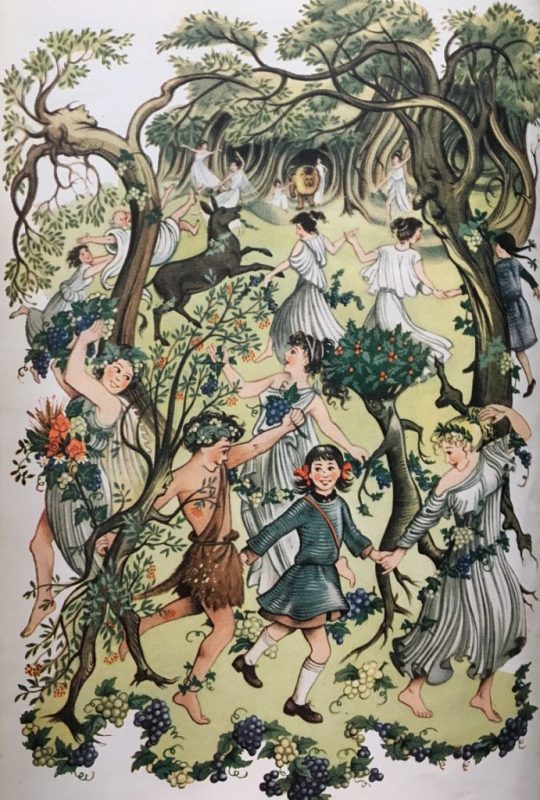
“Aslan’s Romp,” by Pauline Baynes
When morning comes, Aslan sets about the work of putting things to right in Narnia. Aslan’s work, once again, is not aiding Caspian, Peter, and Edmund in their desperate negotiations (and later duel) with the despot Miraz. The “work” is freeing a bunch of girls from their stuffy school, freeing a teacher from her miserable duties, breaking down the Bridge of Beruna, turning a child abuser into a tree, breaking the chains of dogs, freeing horses from their burdens, making old donkeys young again, and healing a half-dwarf who turns out to be Caspian’s nurse. Along the way, “everyone was laughing, flutes were playing, cymbals clashing. Animals were crowding in upon them from every direction.” Silenus is (drunk?) on his donkey. Bacchus, draped in vines, is leading a troop of madcap dancing girls.

No matter the outcome, this duel won’t save Narnia.
It seems like insanity. (Of course, some of it is wish-fulfillment for Lewis who saw the encroachment of industrialism, practical science, and modernism in education as problematic for various reasons. Hey, if you can’t torch it in real life, you can torch it in your fantasy novel.) But while Peter and Caspian were fighting to restore Narnia’s political regime, Aslan was restoring Narnia’s soul. His work was more important. What good would it have been for Caspian to be crowned king and the Old Narnians allowed to live freely, if the trees still slept, magic remained dead, and the spirits and gods that gave Narnia its unique vitality remained in exile?
Looking at society today, there is a sense of the same struggle. Conservative religious types want a return to an idealized earlier era where the government, by their account, was in lockstep with the church (or one faction of the church). Liberal anti-religionists think their anger and rancor are all that is needed to force change and bring about a just, fair, and equitable society. Either side could achieve their goal at the expense of the other, but the outcome would leave a heartless, joyless society, devoid of true celebration. The outcome of such battles cannot result in true revival.
True revival begins, not on the battlefield (whether literal or metaphorical), but on the playground and around the dining table and in living rooms. Revival begins when our hearts reawaken to the old ways we seem to have forgotten: the ways of neighborliness and friendship, of feasting and frivolity, of story-telling and community, of laughter and love and longing fulfilled, of dance and delight in simple things.
Impossibly, after centuries of repression, that’s how Narnia was restored.

The Great Bridge Builder approves of the destruction of the Bridge of Beruna.
The Telmarines feared that which they could not control—the wild, impossible magic of the land they had conquered. So they tried to stamp it out. They walled themselves off from it. They let their fear drive out magic and love, and so became a cruel and heartless people.
That’s the way our world is going. We’re letting fear drive out love and dreams and simple things. Fear of the other. Fear of open doors and open hands. Fear of the possibilities. And if we succumb to fear, we wall ourselves off from love and magic—things which no law, no election, no regime change can restore.
Our only hope is revival—recreation—in the way Aslan brings it: a tidal wave of unrepressed and exuberant charity expressed through friendship and feasting, the breaking of chains, the correcting of injustices, care for nature, and the righting of wrongs wherever they are found. Only then will we reawaken joy and magic and general happiness and peace.
Prince Caspian: A Parallel of the Apostle Paul?

Prince Caspian on the Road to Damascus
Years ago, shortly after reading Prince Caspian and watching the movie, I was reading through the Book of Acts. I don’t remember how far along I was in the book—but it must have been more than halfway—when it jumped out at me: oh my gosh, Prince Caspian is the story of the Apostle Paul; everything lines up!
Due to the common misconception of what an allegory is, people often mistake The Lion, the Witch, and the Wardrobe as being such. It is, in fact, as Lewis called it, “a supposition”—similar to the modern fantasy-genre retellings of classic fairy tales and myths that have become popular of late. They answer the question: How would this have happened in another world or another time? I think, whether Lewis intended it or not, Prince Caspian is that kind of story—a supposition of what the aftermath of Jesus’ resurrection would have looked like in Narnia. (Obviously, I’m ignoring the time difference between Jesus’ resurrection and the events of the Book of Acts in our world and Aslan’s resurrection and Prince Caspian’s time in Narnia.) The rough approximations look like this:

Prince Caspian tries to convince the Old Narnians he’s not like the rest of the Telmarines.
The Old Narnians represent the first century believers.
The Telmarines represent the Jewish religious authorities who tried to stamp out, sometimes violently, the sect of the Nazarene.
The Pevensies represent the original apostles of Christ who accept, confirm, and aid Caspian in his new journey as a follower of Aslan.
Caspian, destined (at one time) to be a standard bearer of the persecution of Old Narnia, reminds me of Saul who, as part of the Jewish religious establishment, “breathed out threatenings and slaughter” against the followers of the Way.
Caspian’s flight from the Telmarine stronghold and his subsequent run-in with Trumpkin, Nikabrik, and Trufflehunter is his Damascus Road experience.
And just as the believers were suspicious of Saul (later to become known as Paul) and his sudden conversion, many of the Old Narnians are suspicious of Caspian appearing to be on their side.
There you have it. It seemed so apparent to me that I was sure others had thought similarly. But I’ve searched the internet and, alas, it seems I’m the only one.
The Movie
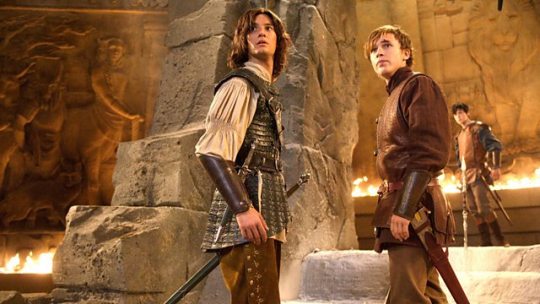
As indicated at the beginning of this piece, I really like the 2011 Prince Caspian movie adaptation. It was gritty, earthy, and lived up to its trailer tagline: “You’ll find Narnia a more savage place than you remember.” I even liked the realistic head-butting between Peter and Caspian and the teasing romance of Caspian and Susan. (The kiss at the end was overkill. When that appeared on the big screen, I, like I’m sure many others, thought, Hey! You have to explain that to Ramandu’s daughter one day.)
But the thing I liked the most was the variety of Old Narnian creatures present at Aslan’s How and in the midnight raid on the Telmarine fortress. Centaurs, mice, satyrs, fauns, dwarfs, gryphons, kid centaurs (centaurlings?), lady centaurs, squirrels, bears, giants. Did I say mice? I loved it.

Good old Narnians
There was one glaring flaw in the movie that I thought, if done away with, would have made a stronger cinematic experience. (Not that anyone cares at this point; but I like carrying on about the mechanics of storytelling whether literary or visual, so bear with me.)
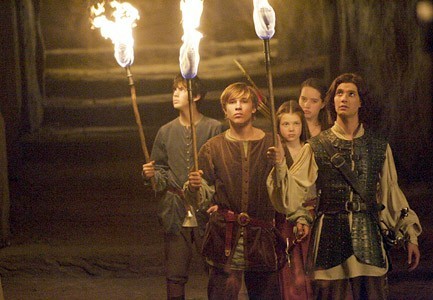
One of these things is not a Pevensie.
From the book, I got the impression that Caspian was about Edmund’s age. However, in the movie, he appears to be older than Peter and is bigger (taller) than all of the Pevensies. The movie tries to play Caspian as a vulnerable, threatened heir to the throne—someone who needs the Pevensies’ help. But it’s hard to believe. You can sense Barnes as Caspian holding back out of deference—when what you should feel is his desperation. This is shown distinctly in a scene close to the end of the movie: after the Telmarines have surrendered, Peter, Susan, Edmund, and Caspian kneel before Aslan. Caspian’s head levels above the Pevensies’, automatically drawing your eye to him. And when the Pevensies rise and Caspian remains kneeling, the result is almost comical: the viewer’s mind says, “one of these things does not belong,” and the scene tries to force you to accept that Caspian “belongs.”
A younger (shorter) actor would not have stuck out so obviously in this scene. Throughout the movie, by virtue of his youth, he would have appeared more authentically vulnerable and threatened—someone who needed help, someone who would have more easily taken advice. And, he wouldn’t have towered over Trufflehunter and Nikabrik in that run through the forest as they were trying to get away from the Telmarine soldiers.
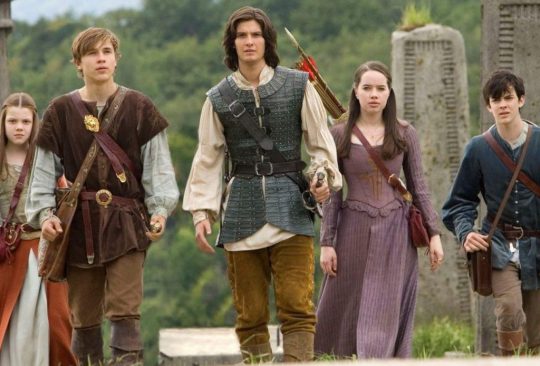
Can you feel those “vulnerable prince” vibes? …Didn’t think so.
To be clear, I like Ben Barnes. I think he did a great job portraying Caspian. But there was a bit of cognitive dissonance when he appeared with the Pevensies on screen. (That accent didn’t help either.)
Go to the article
0 notes